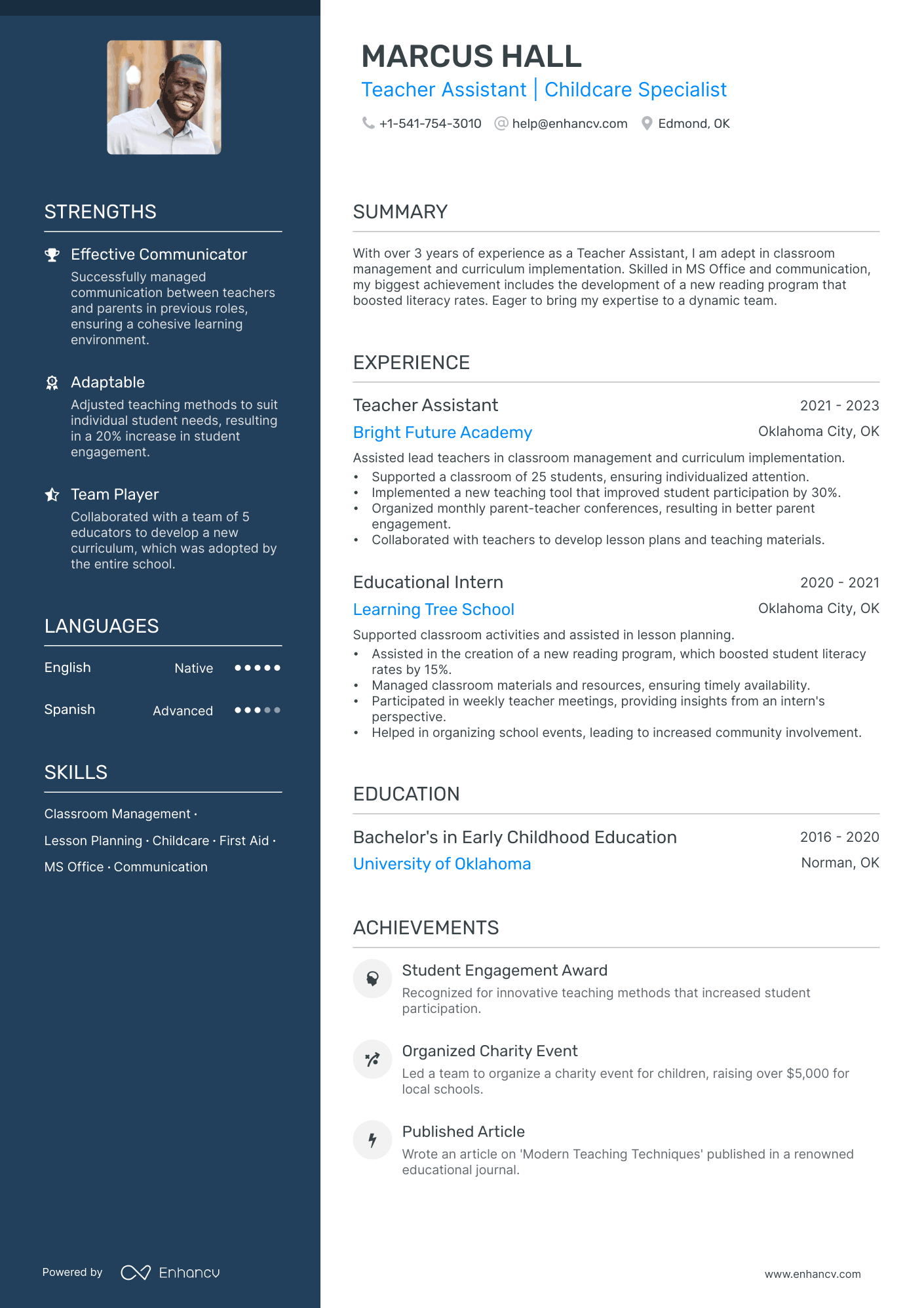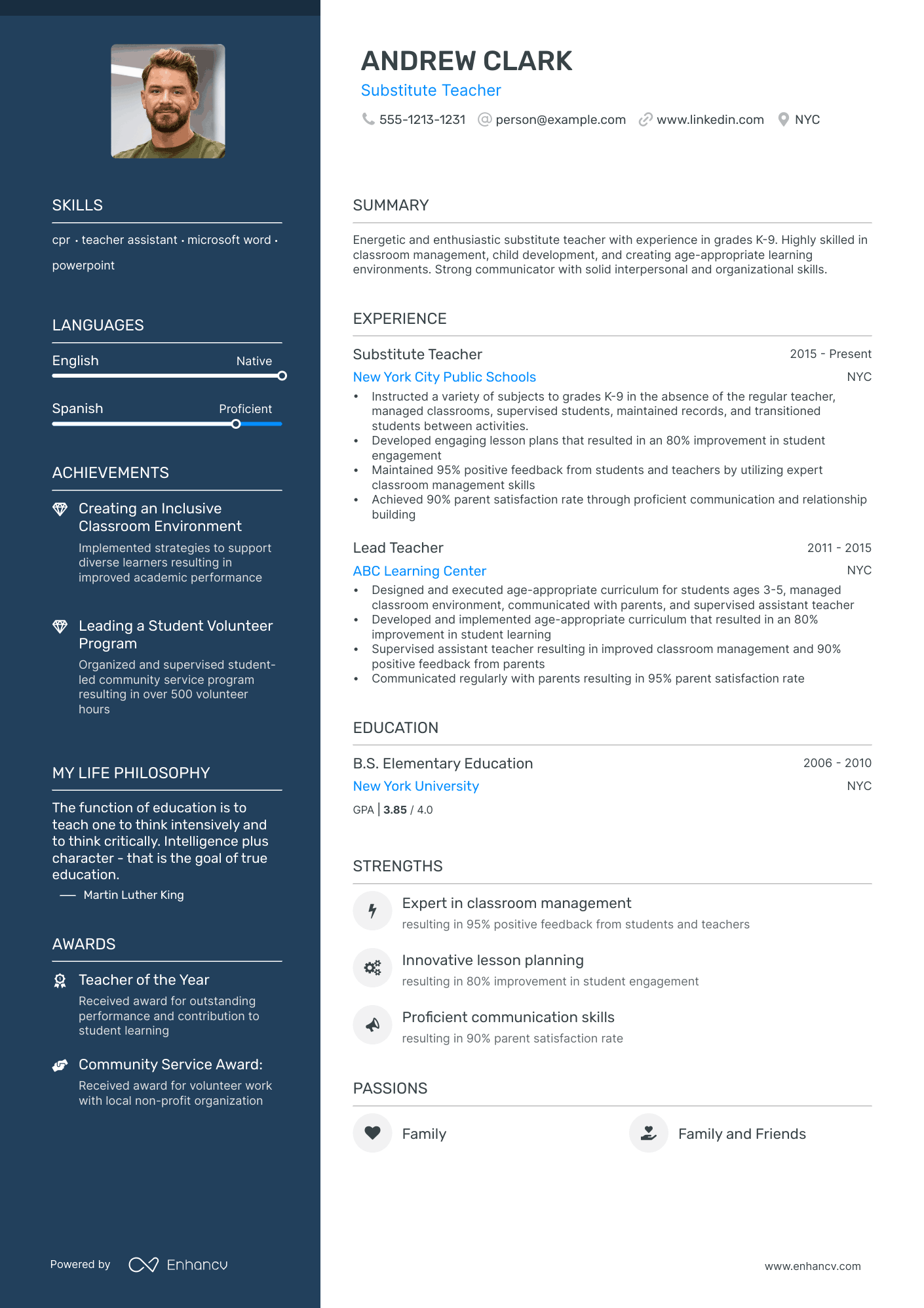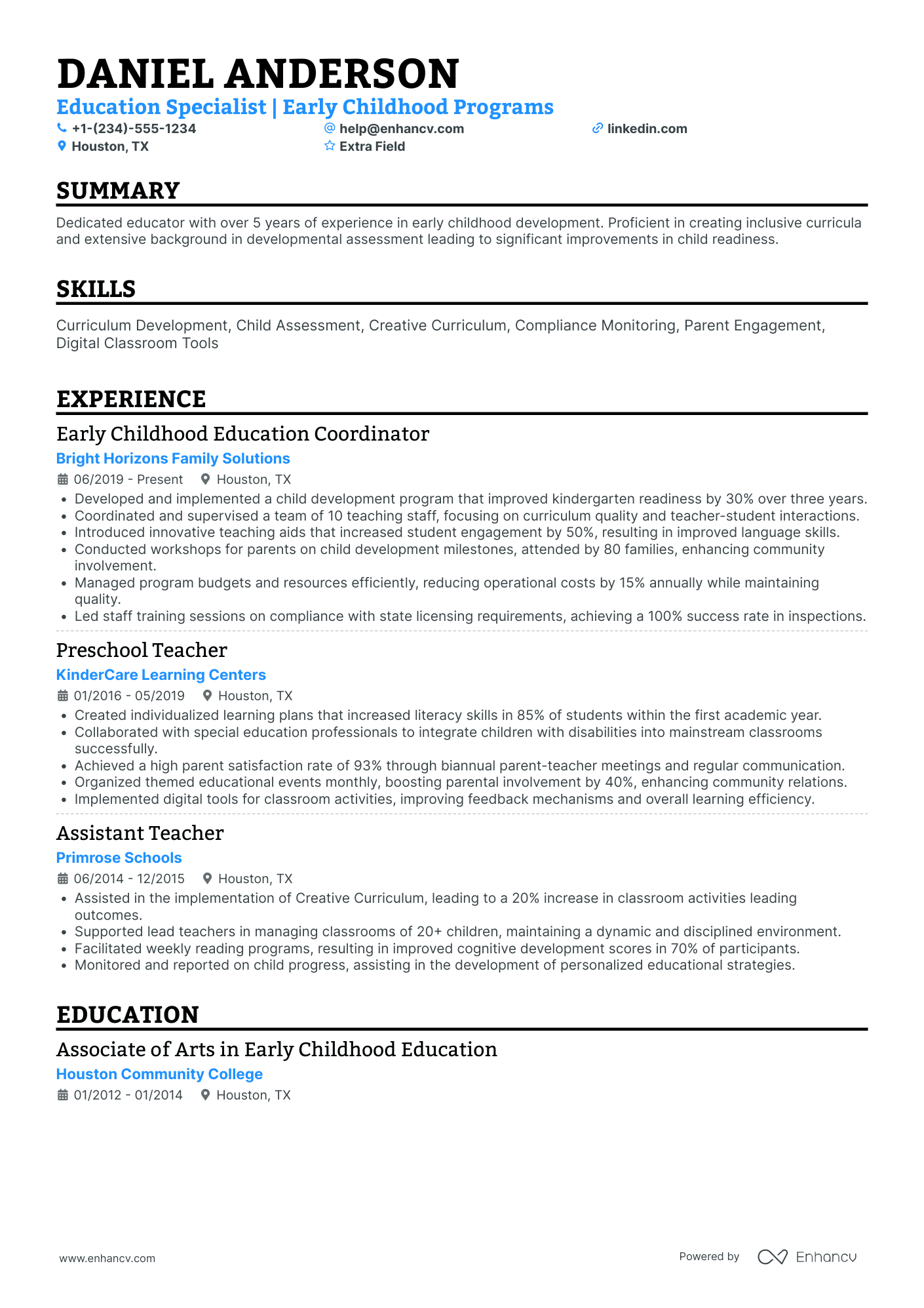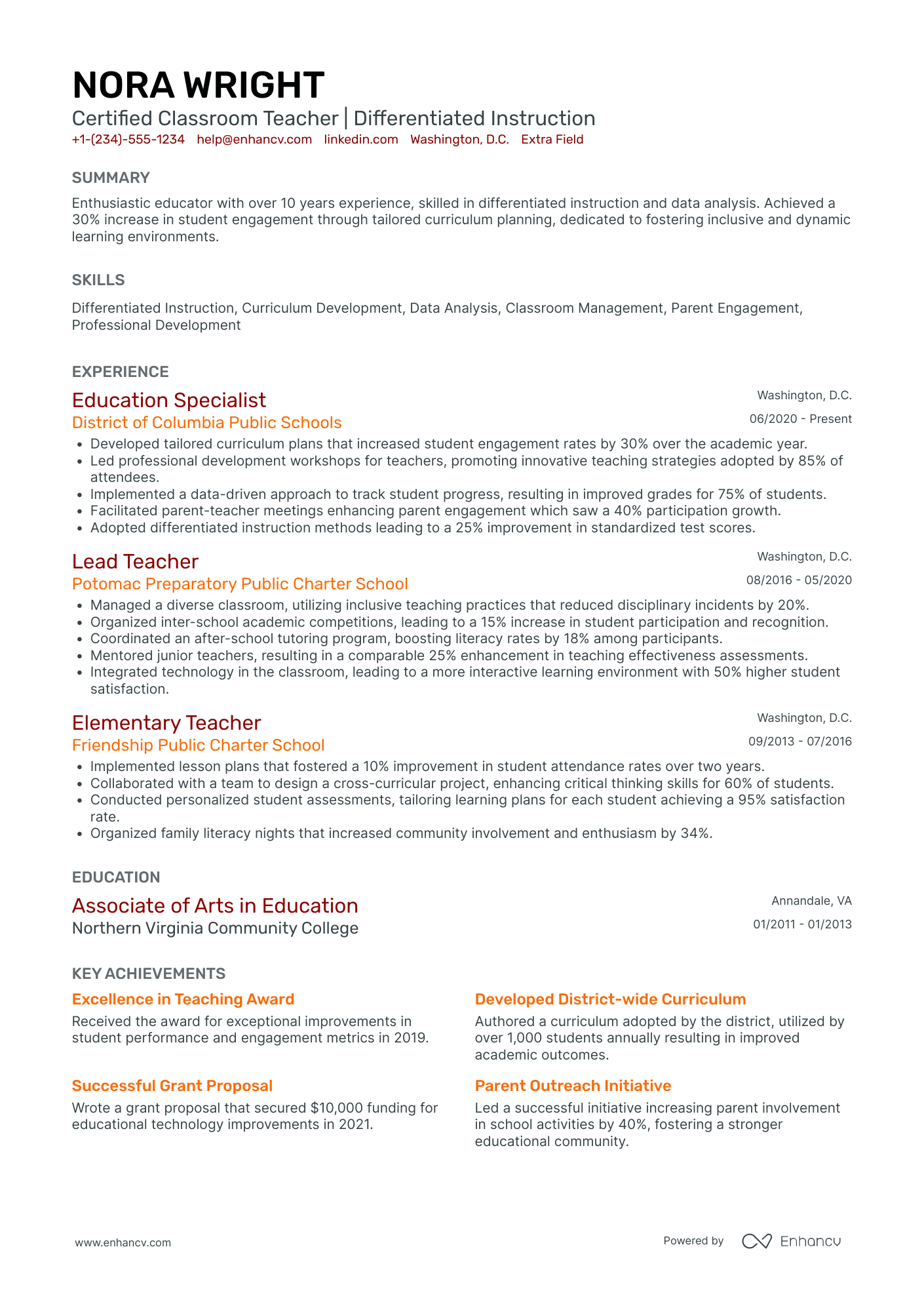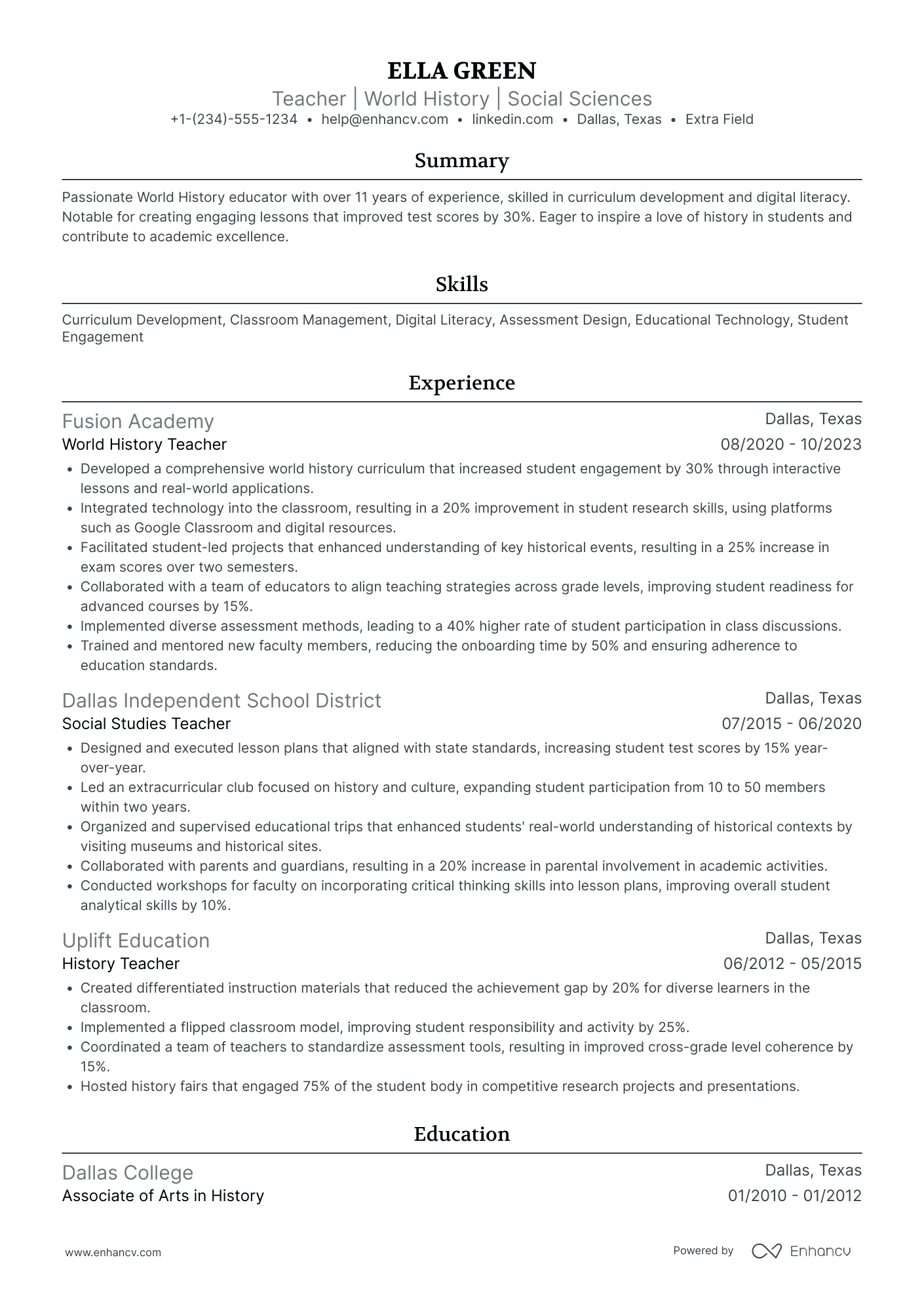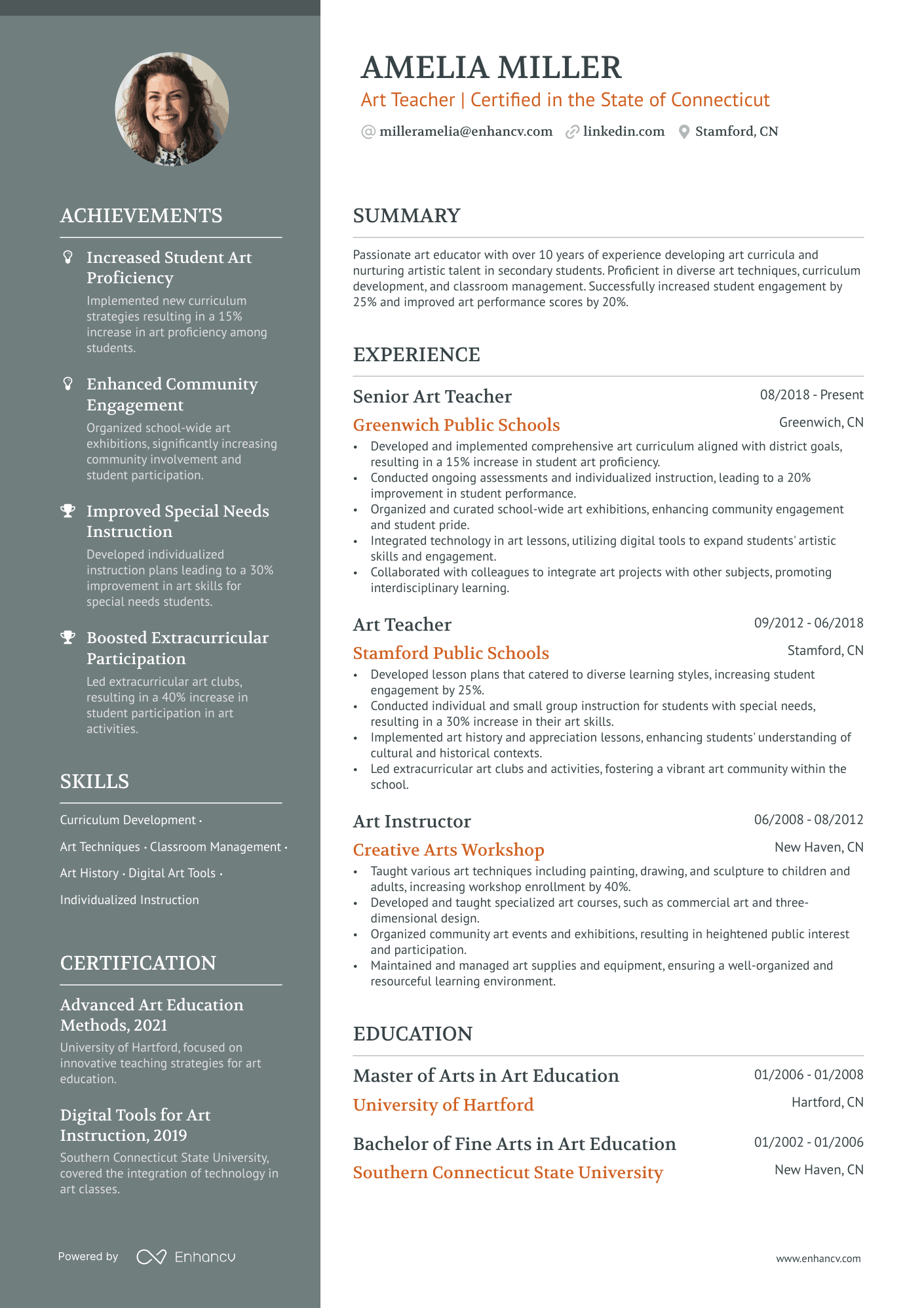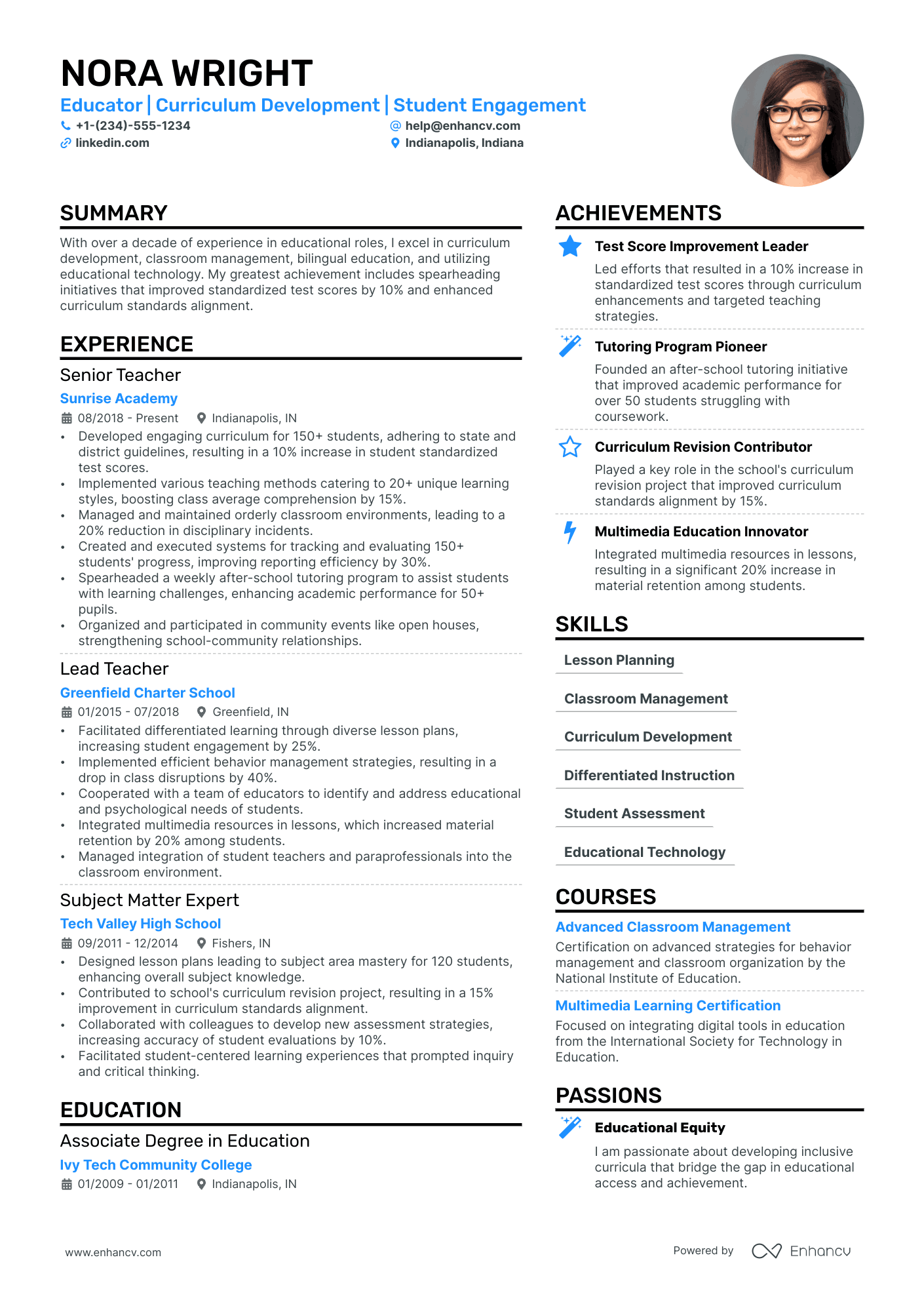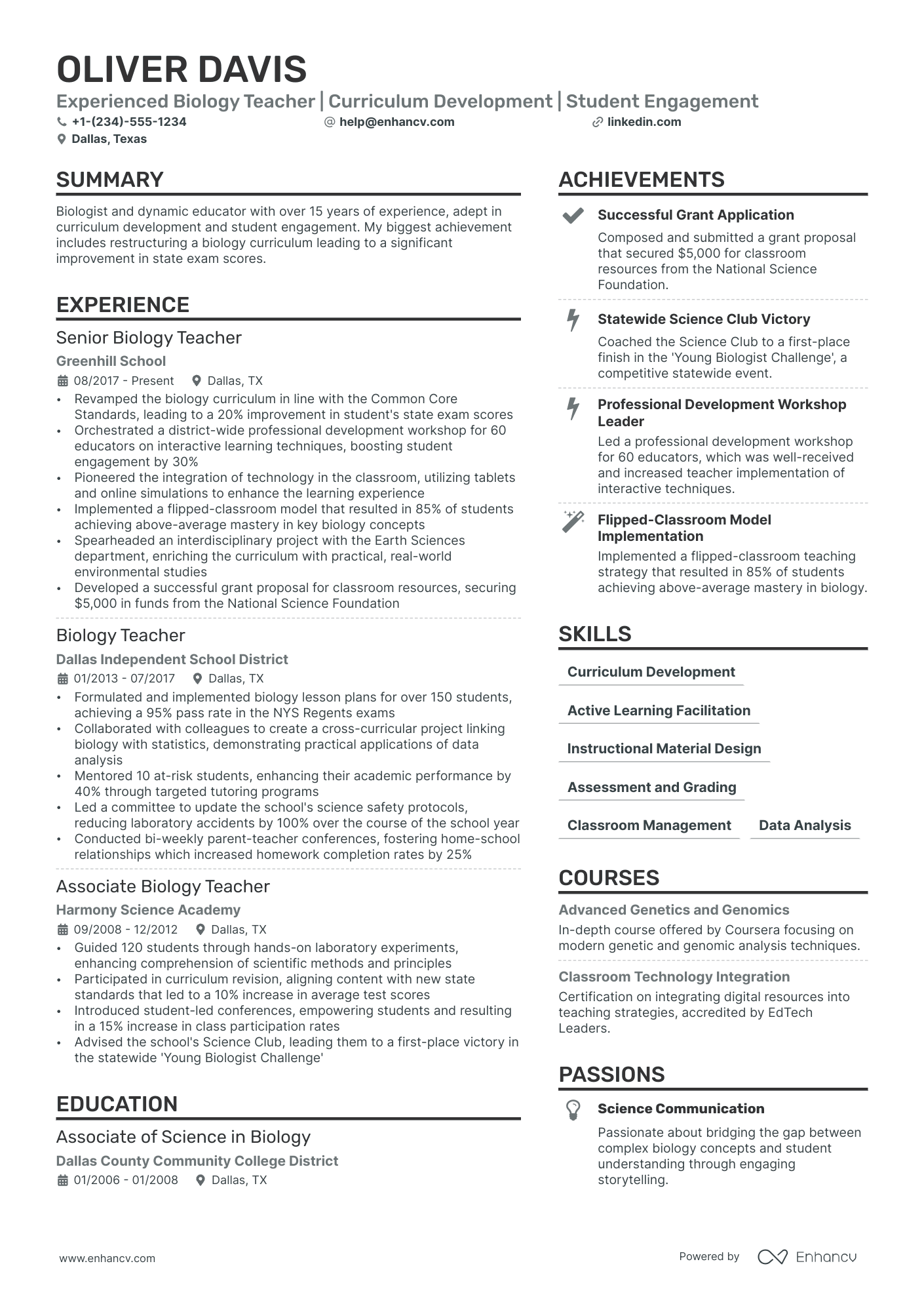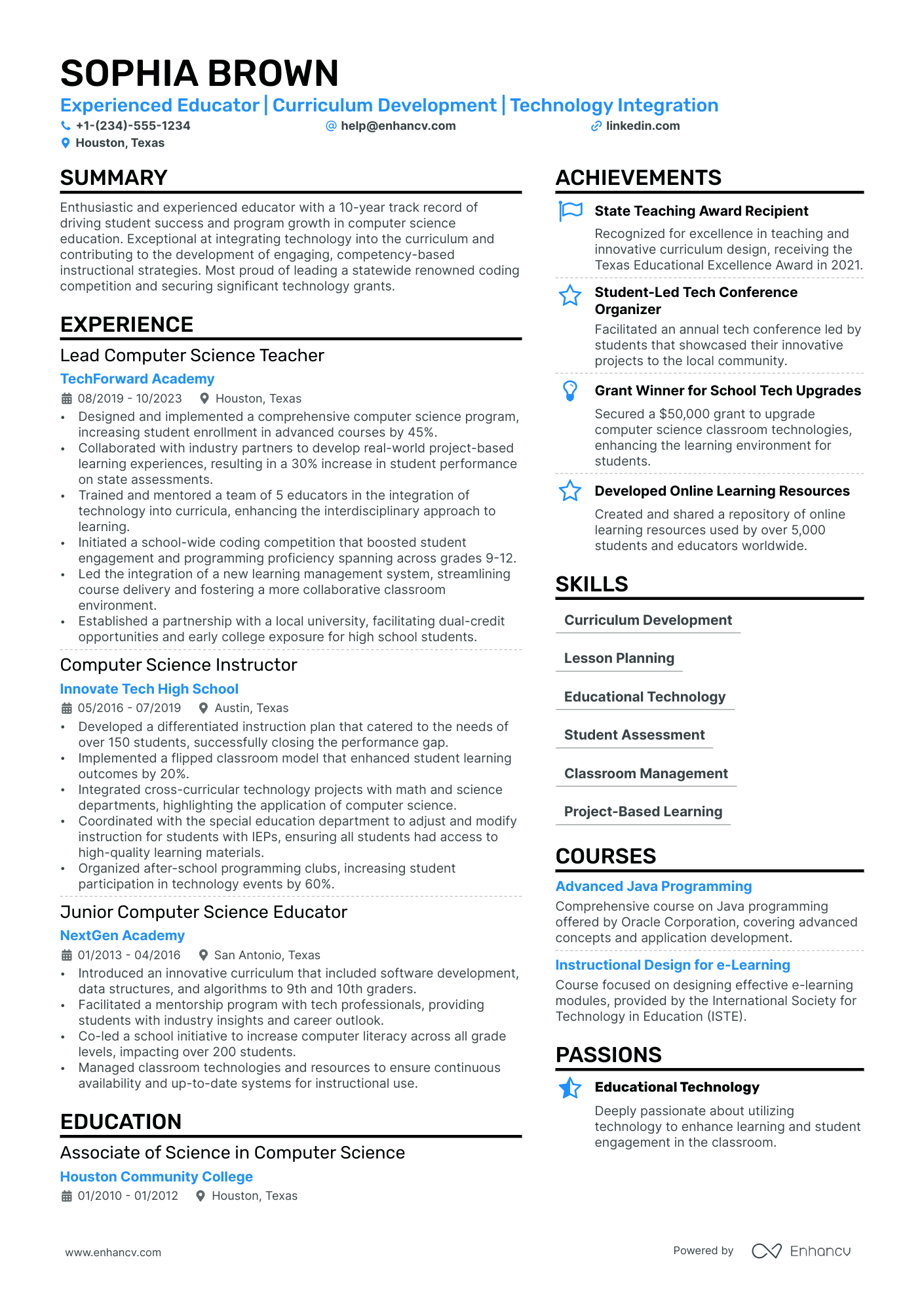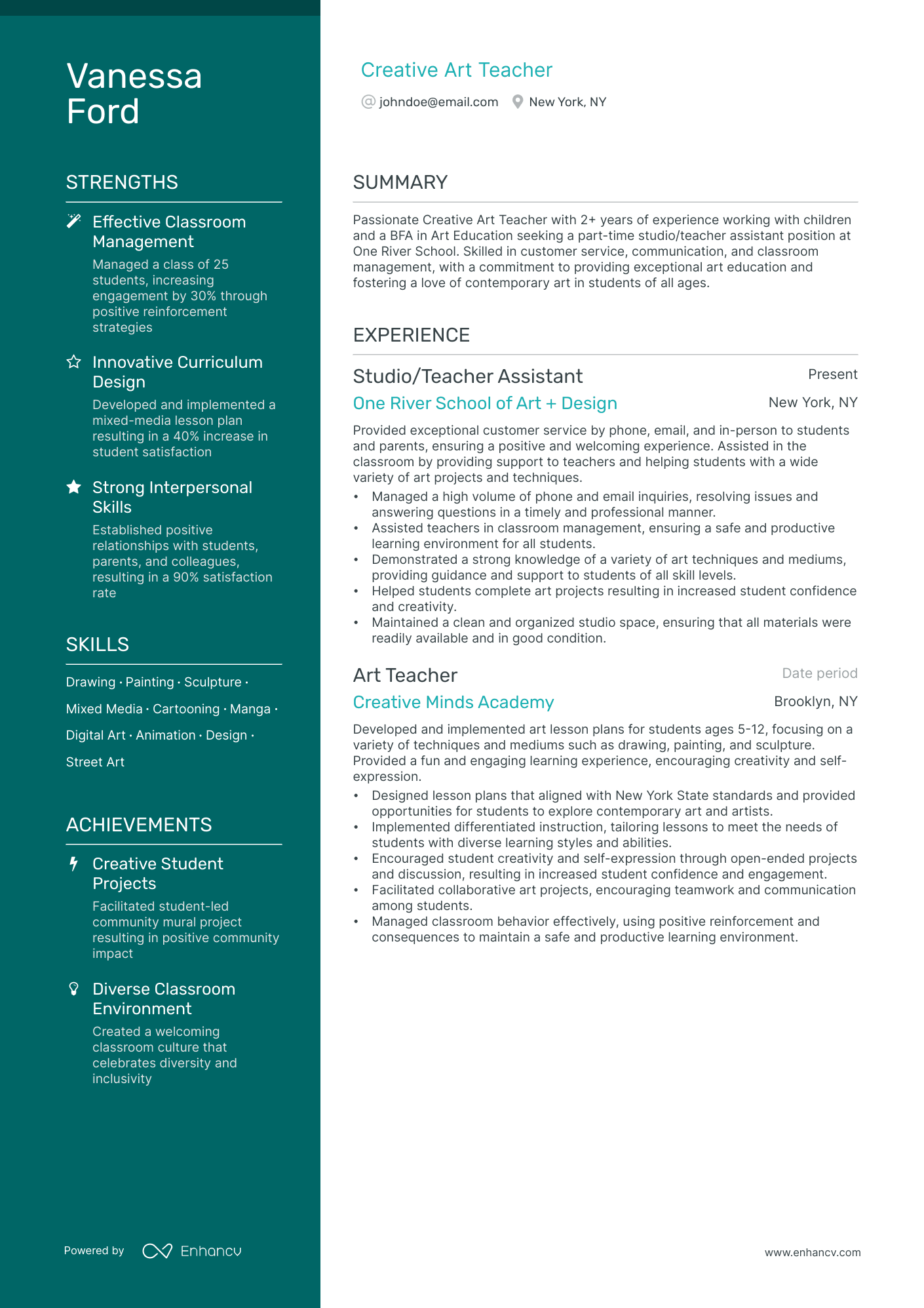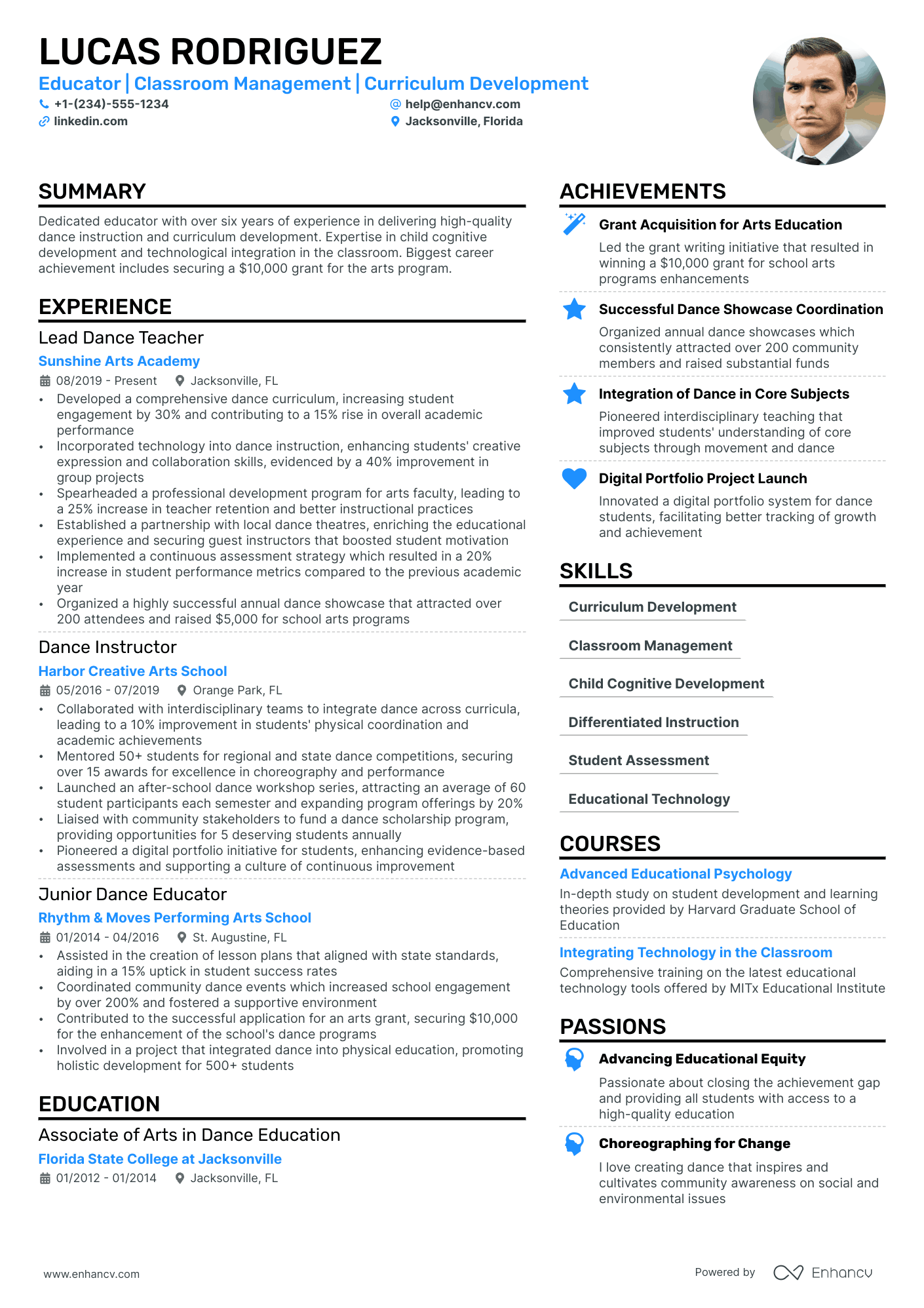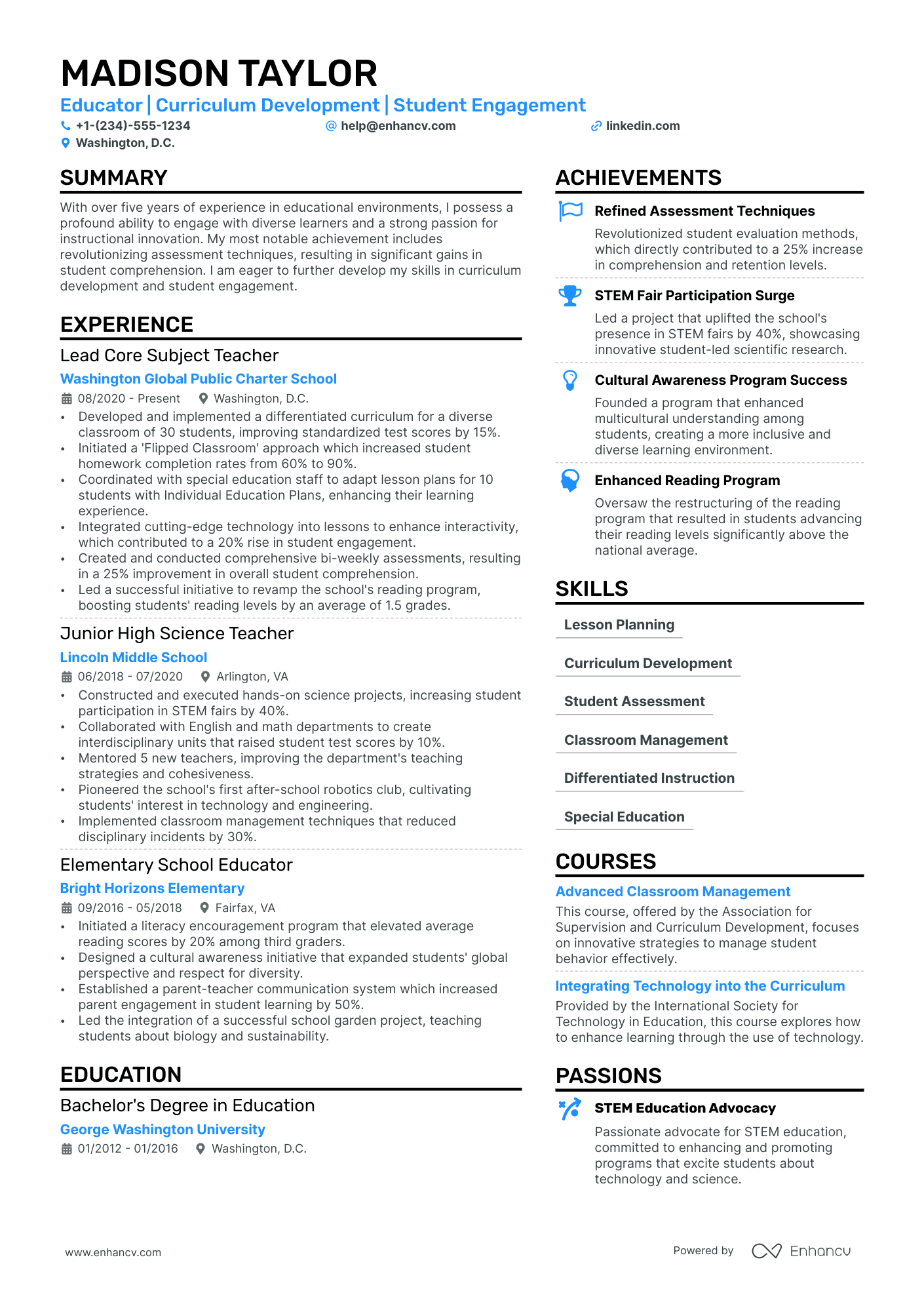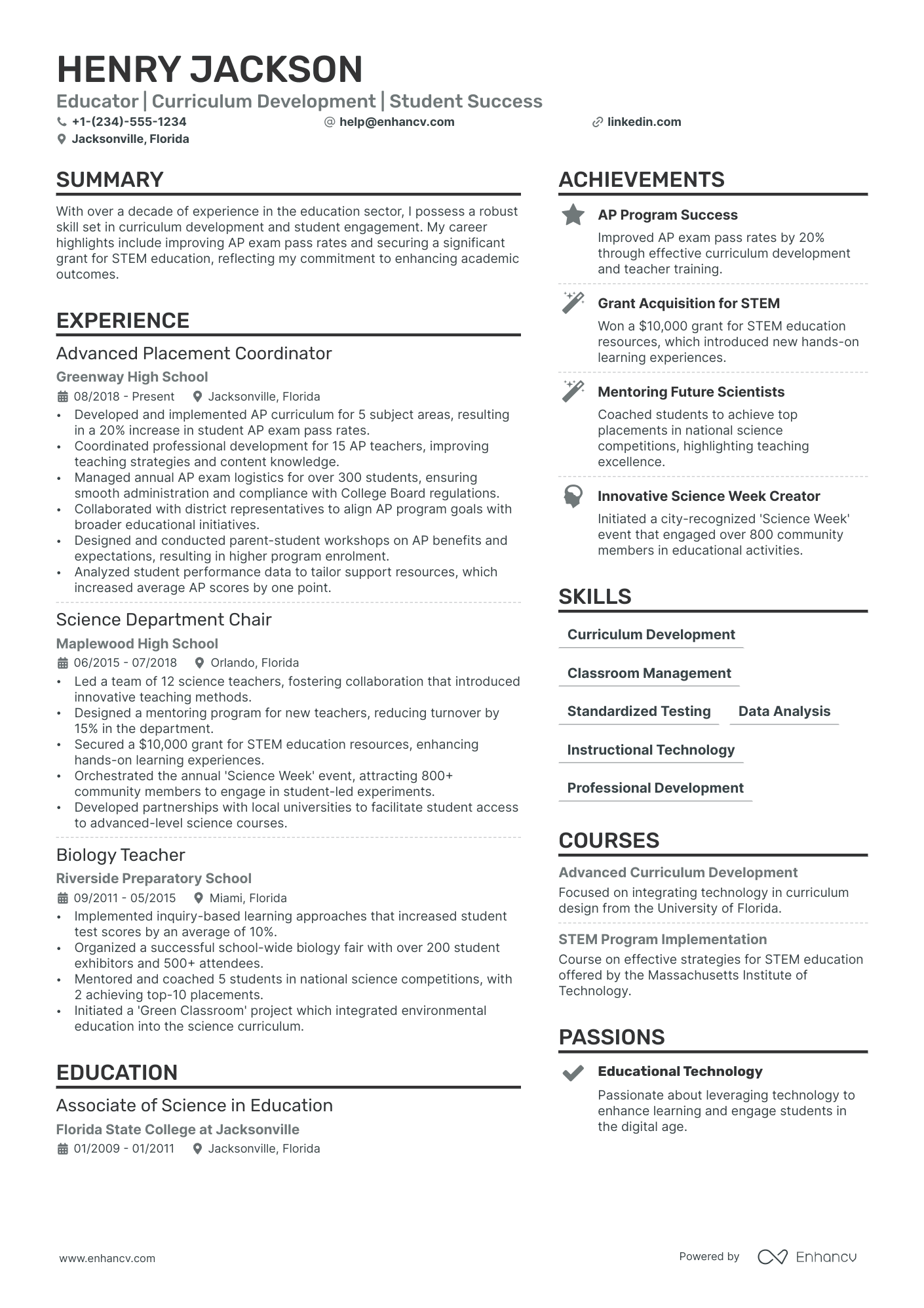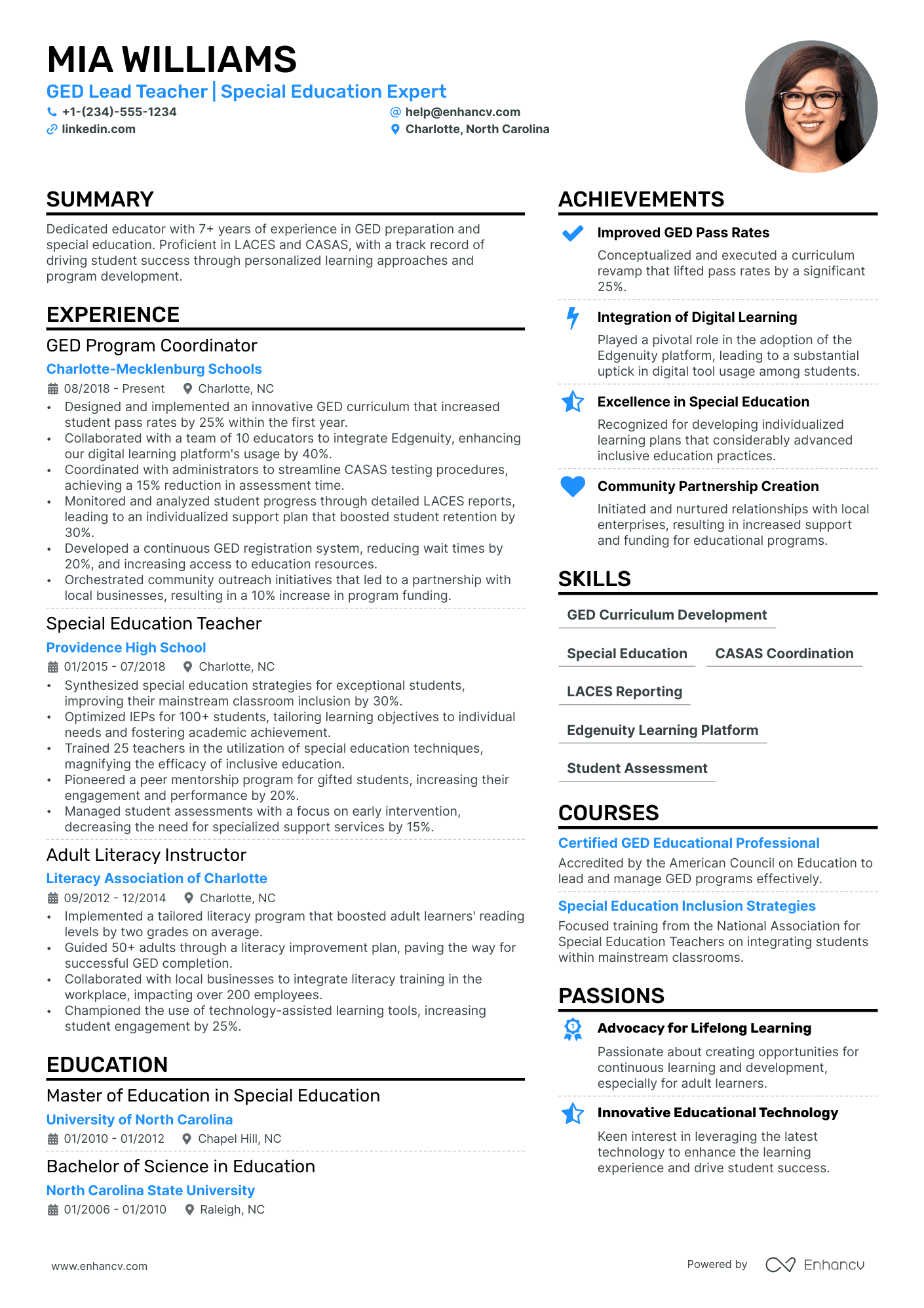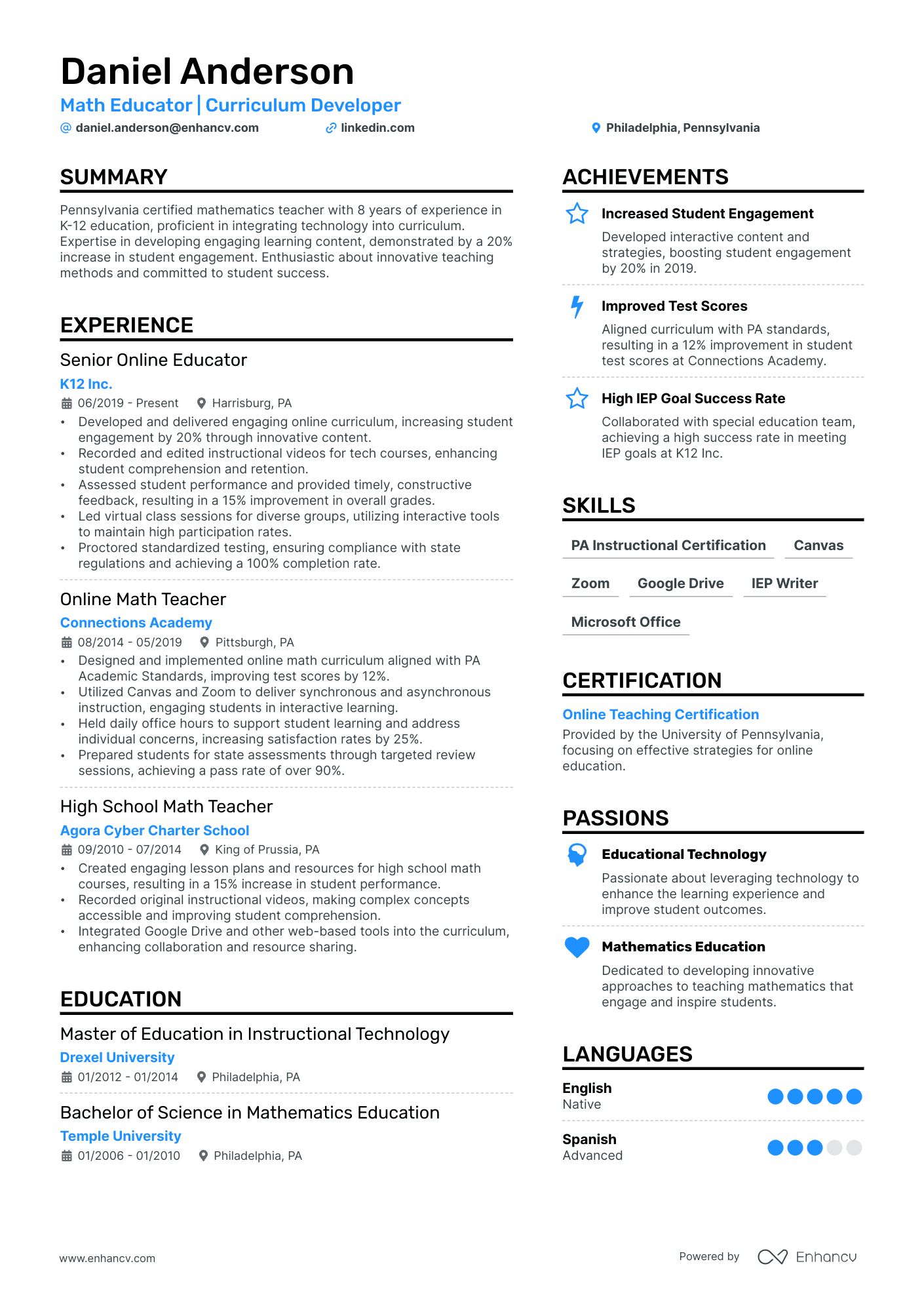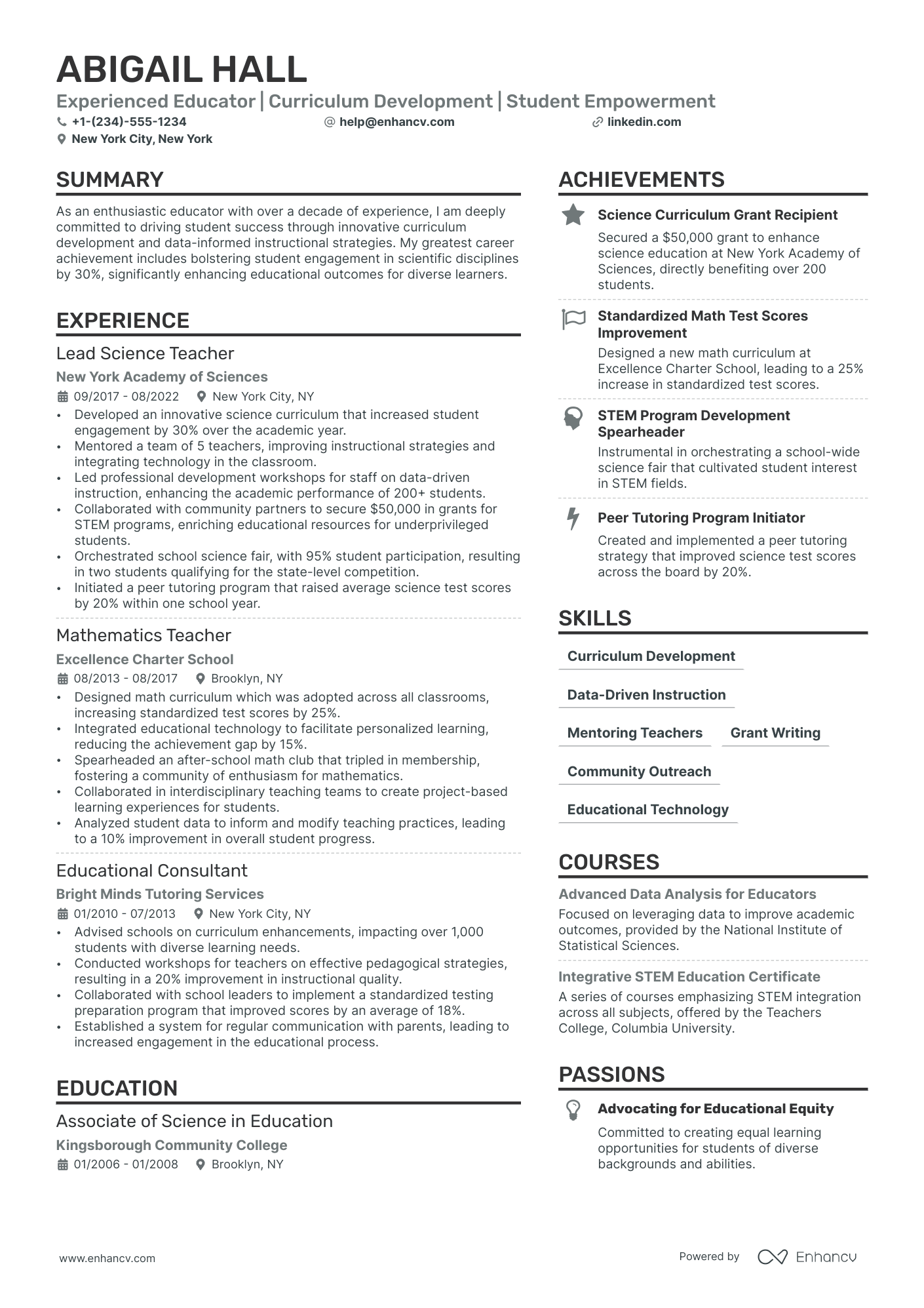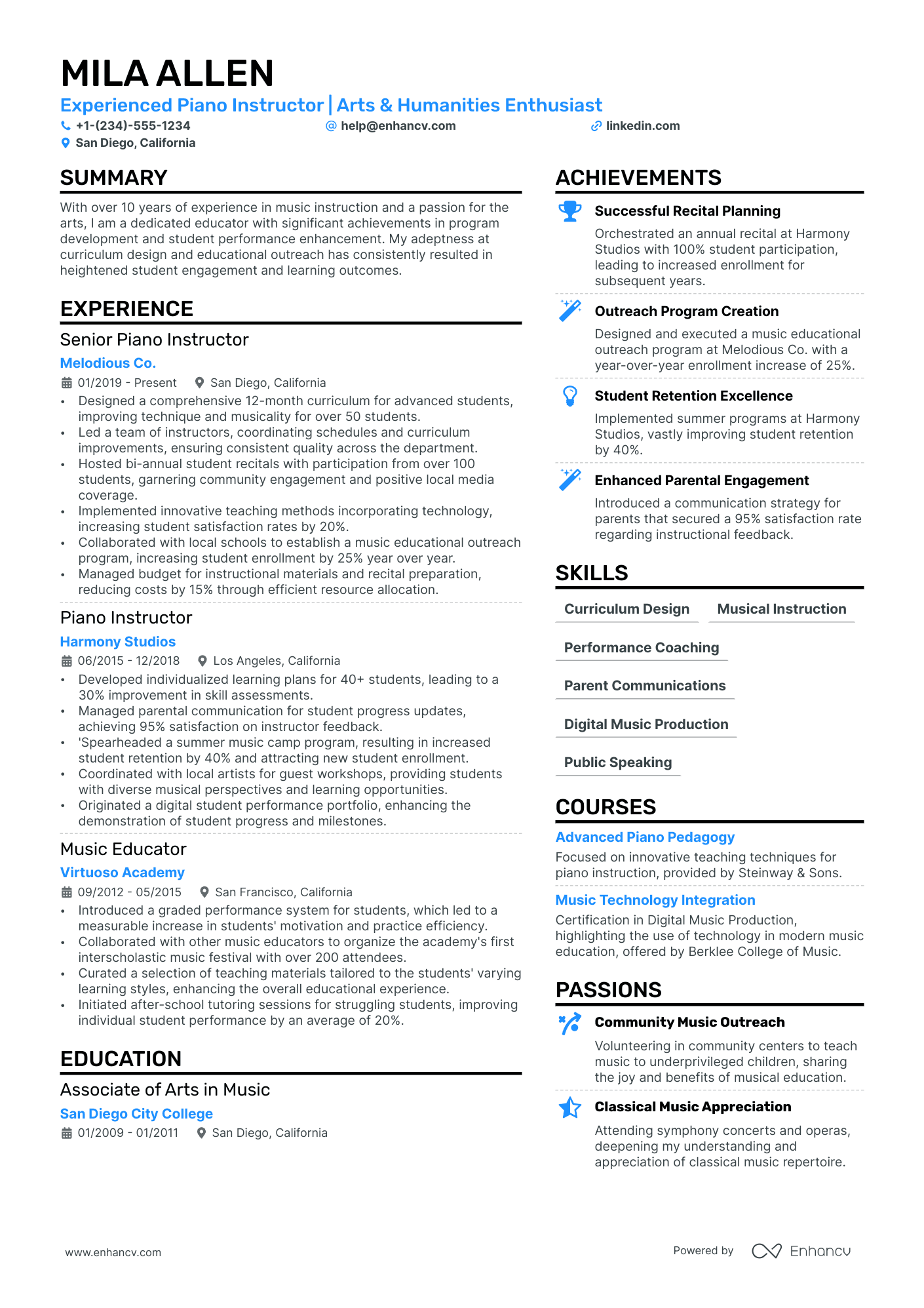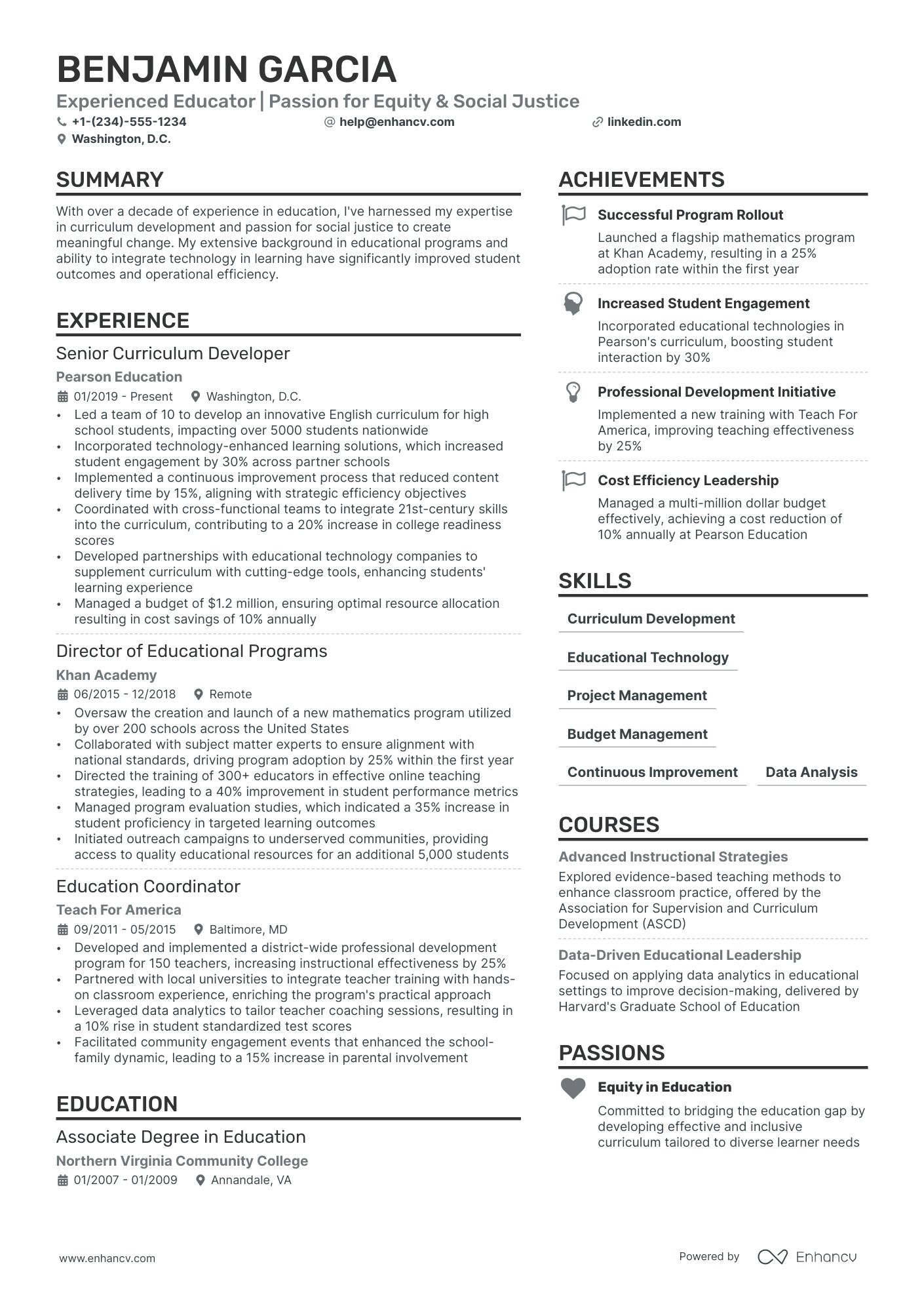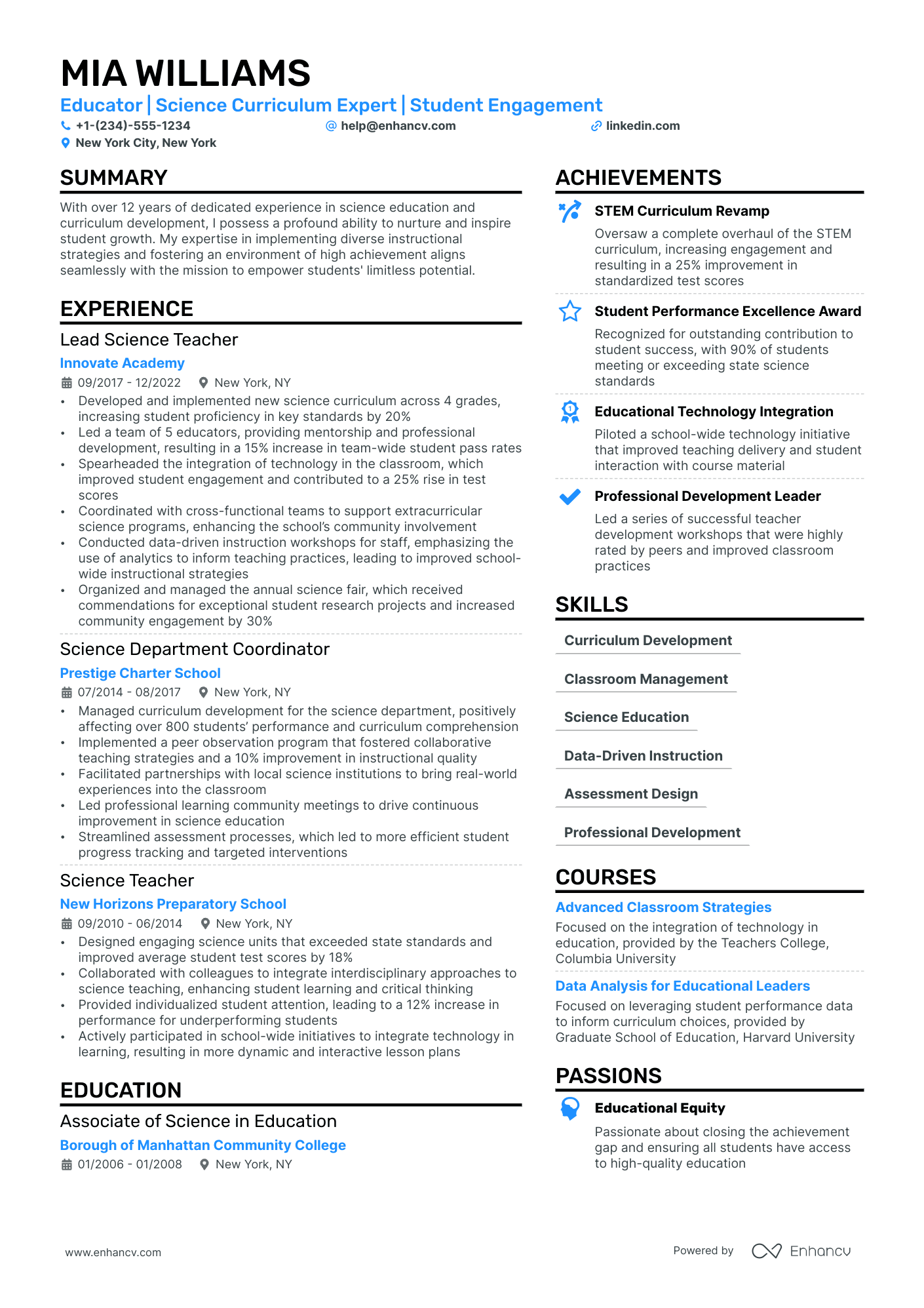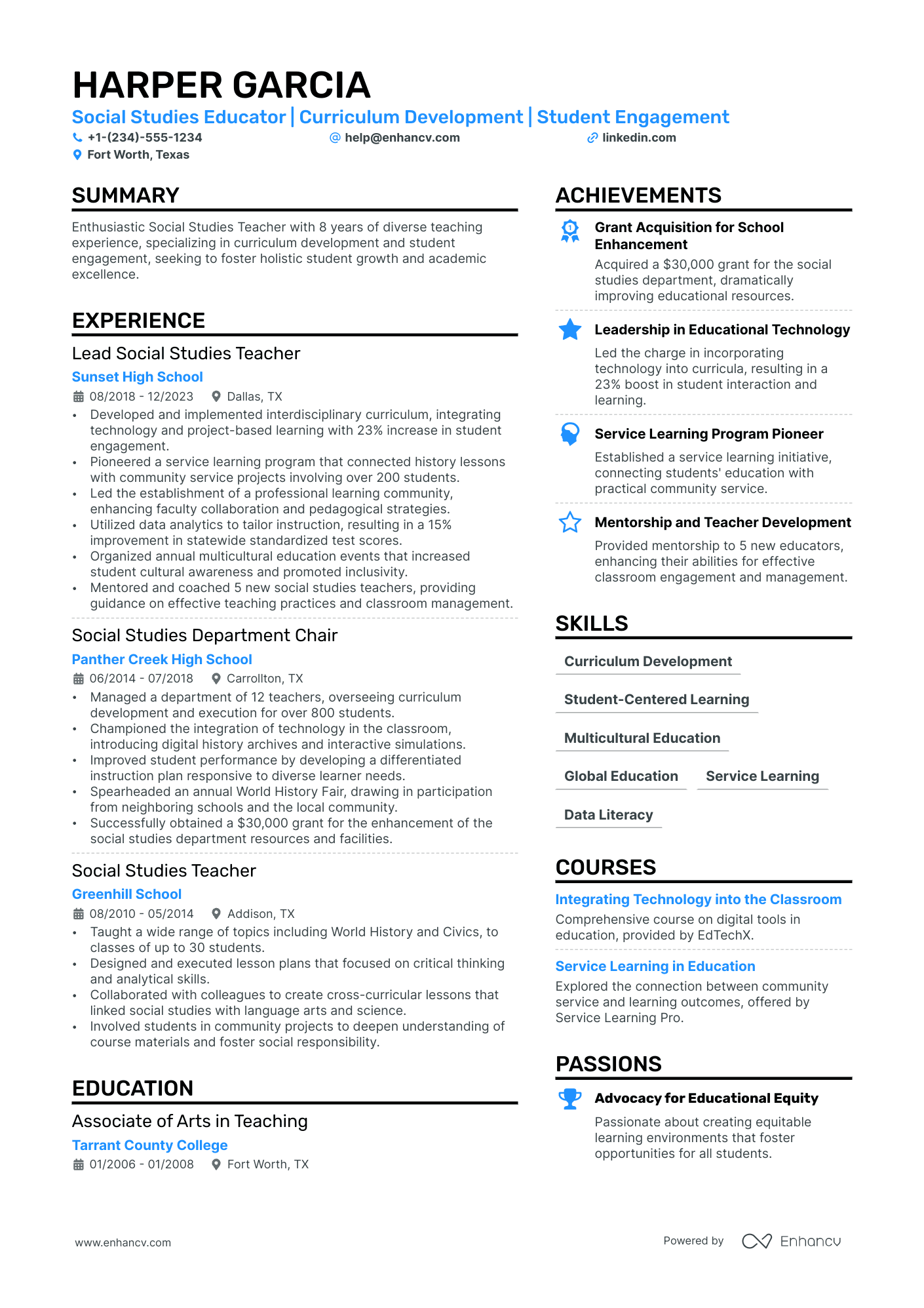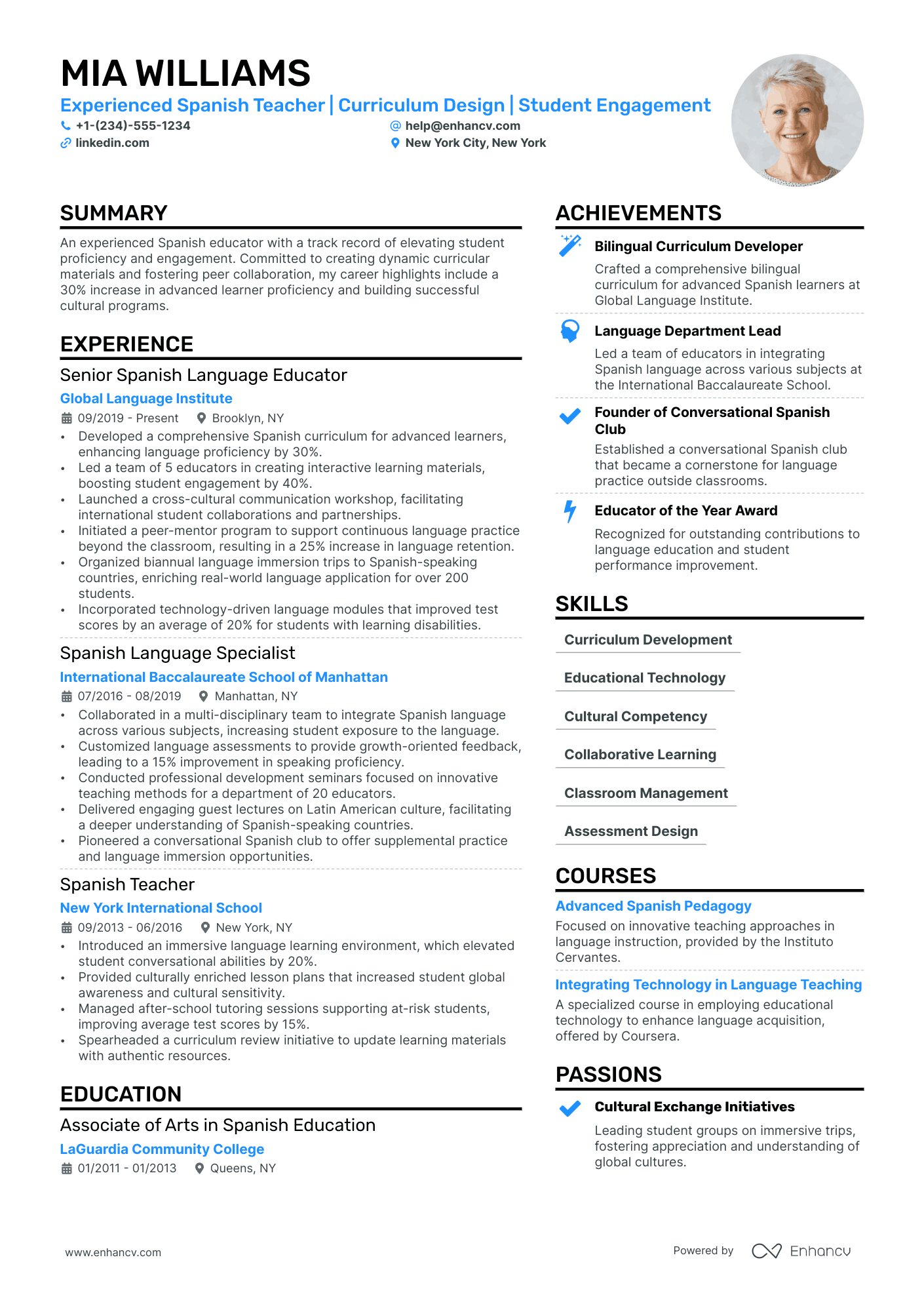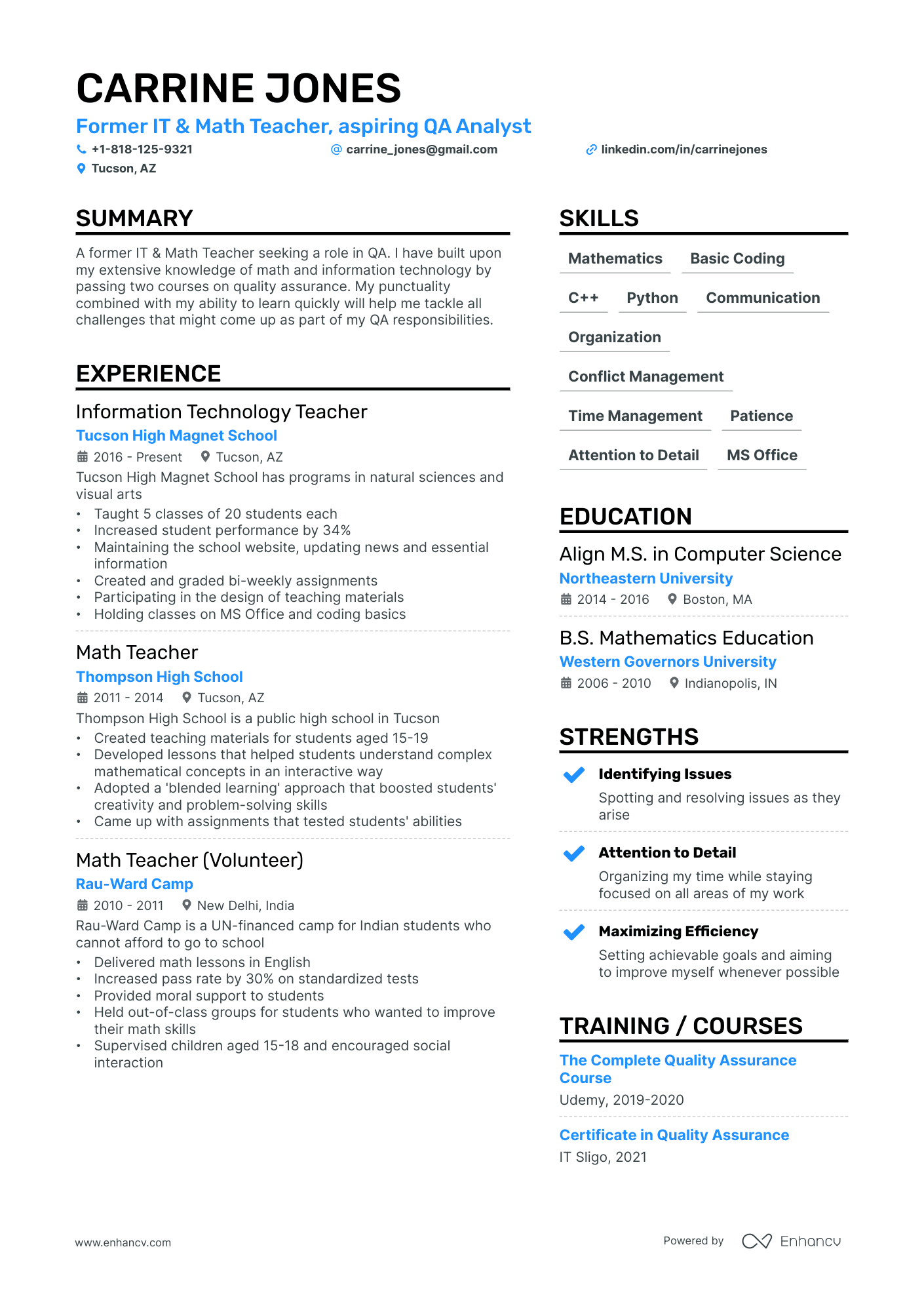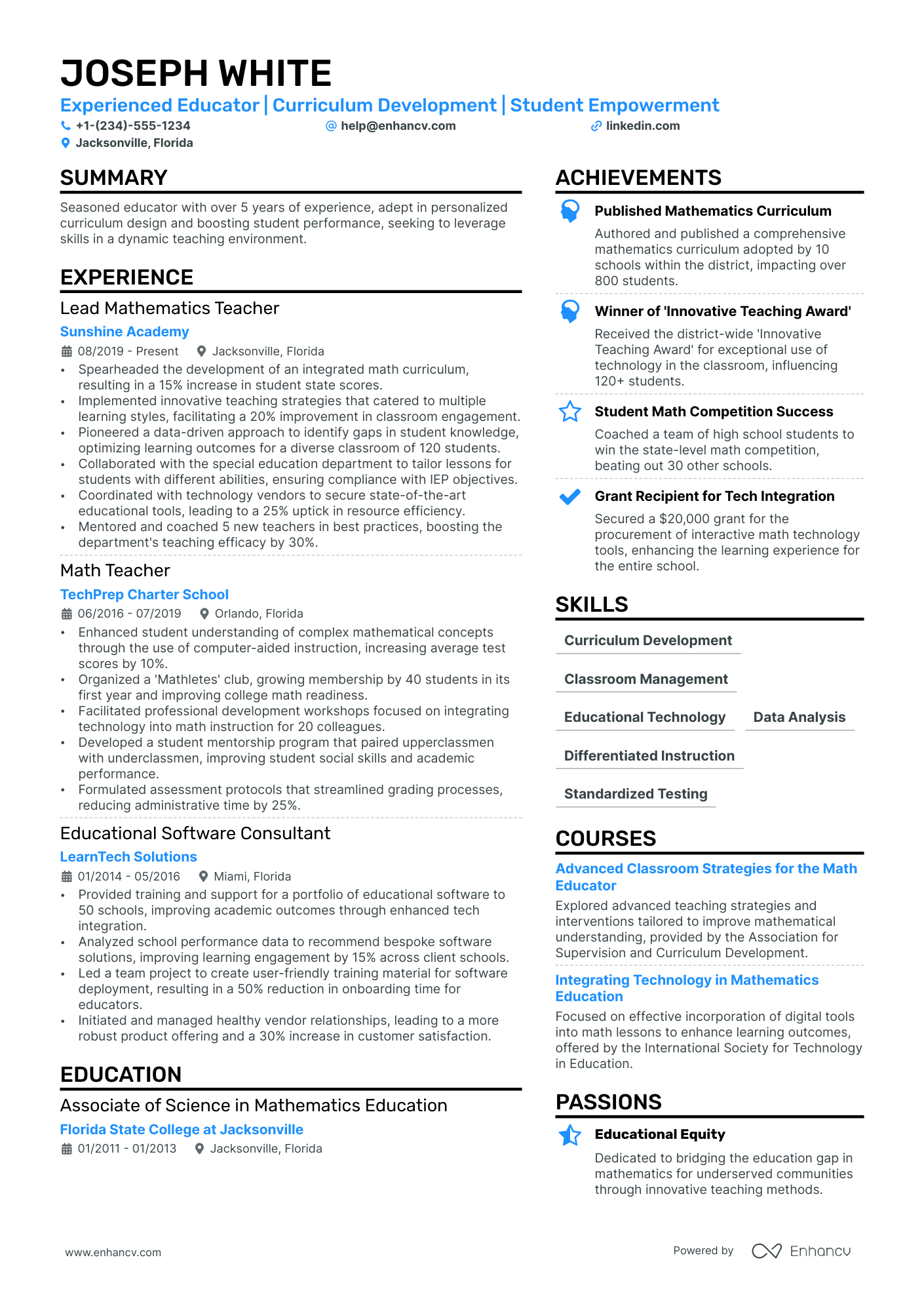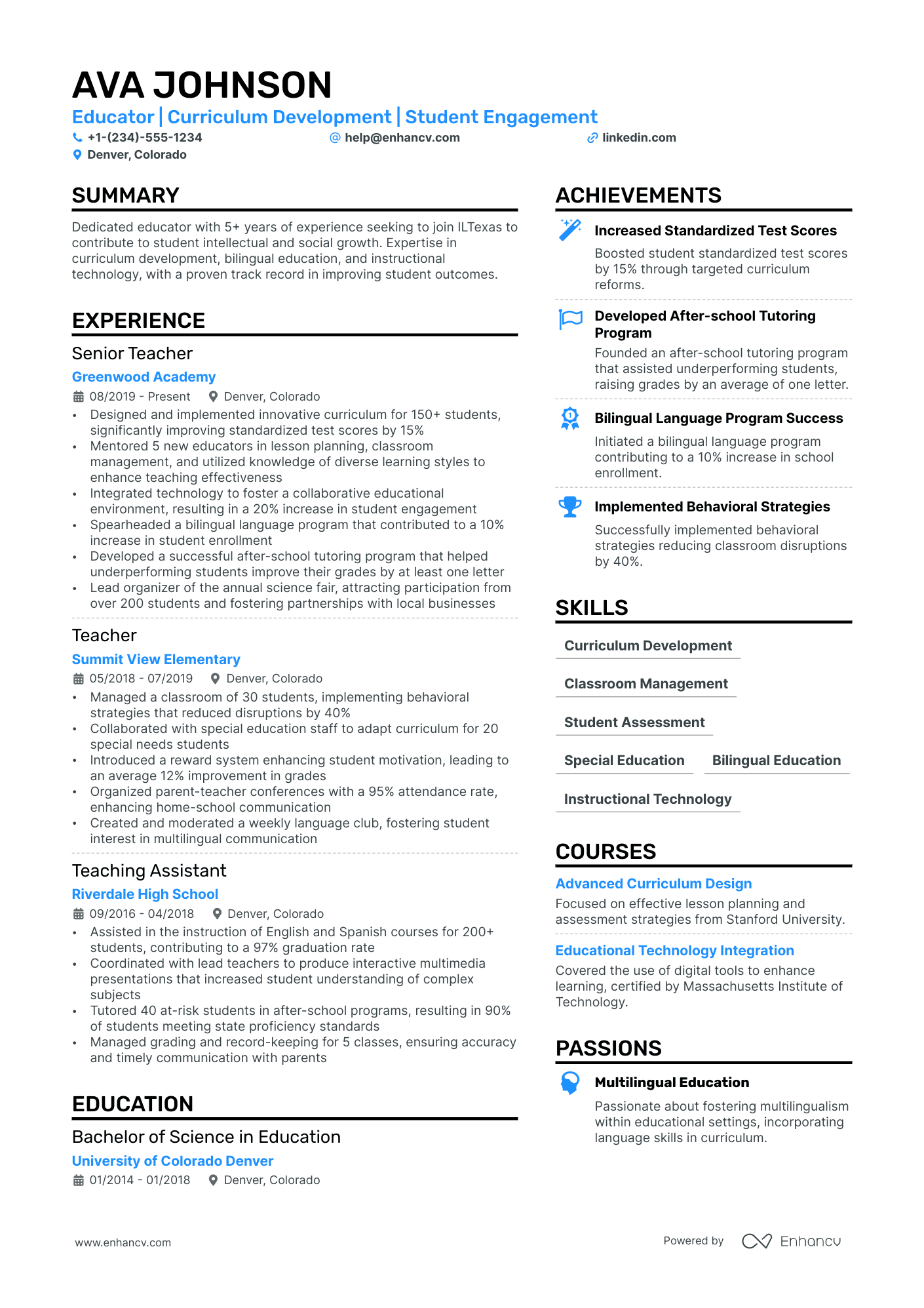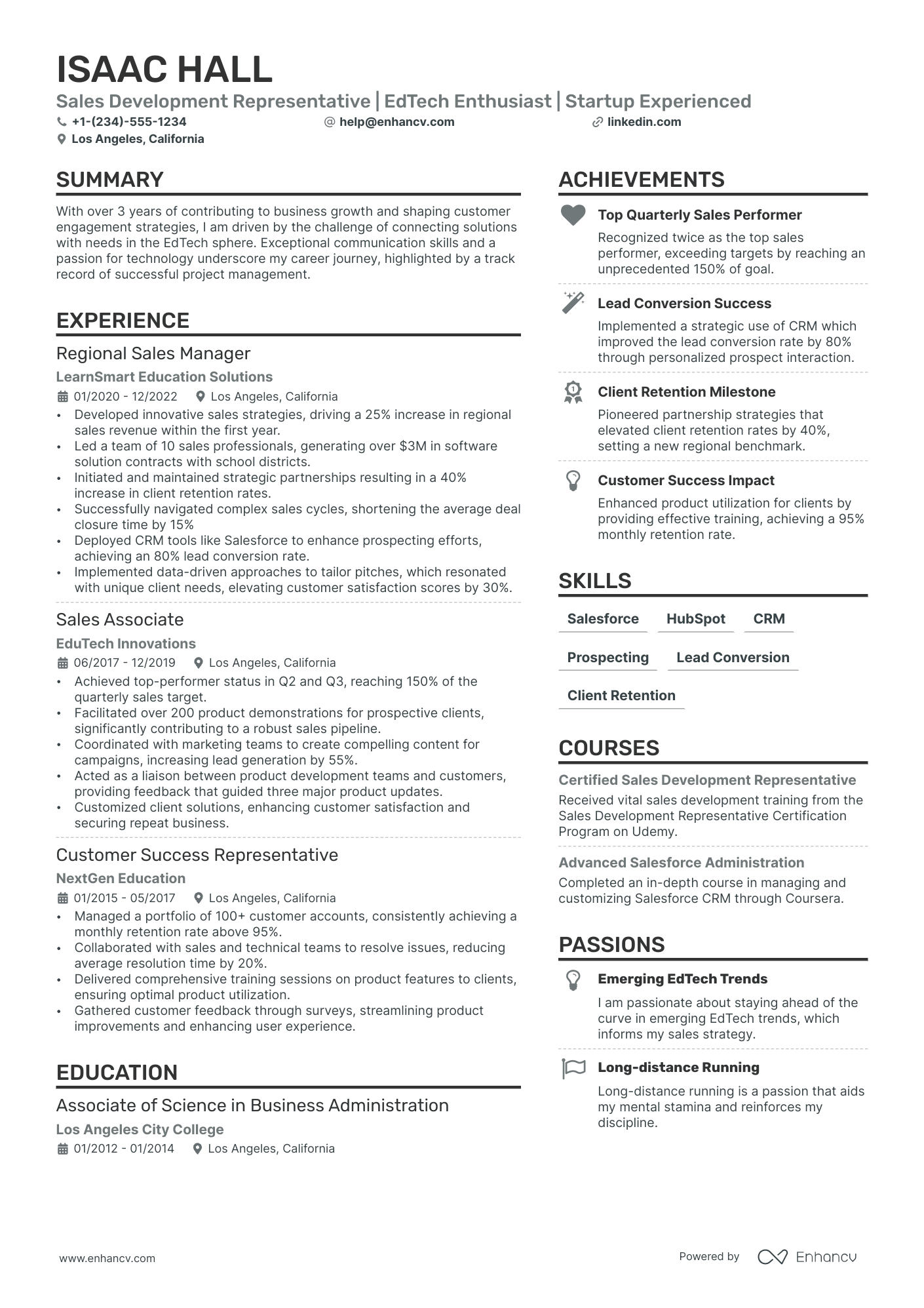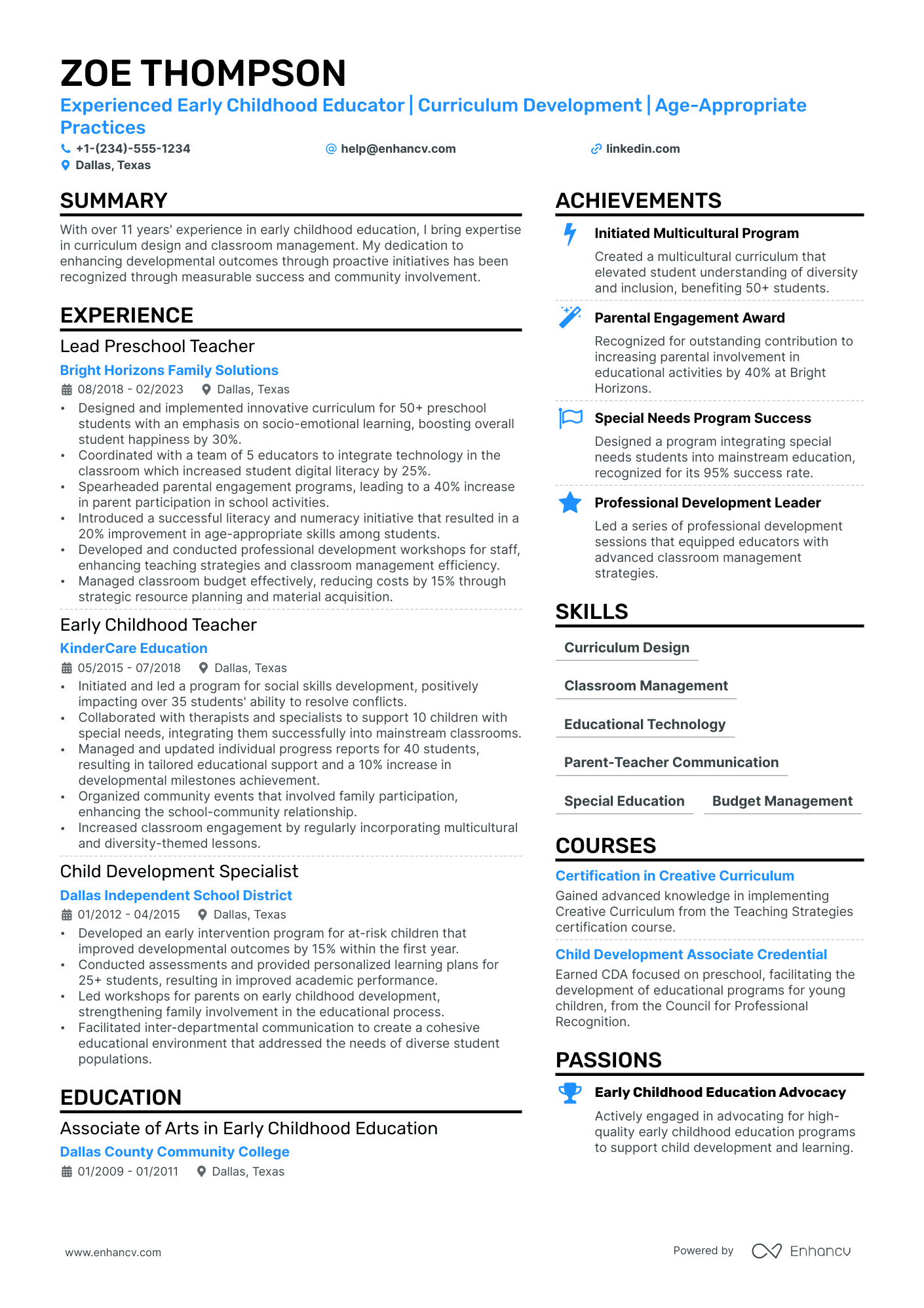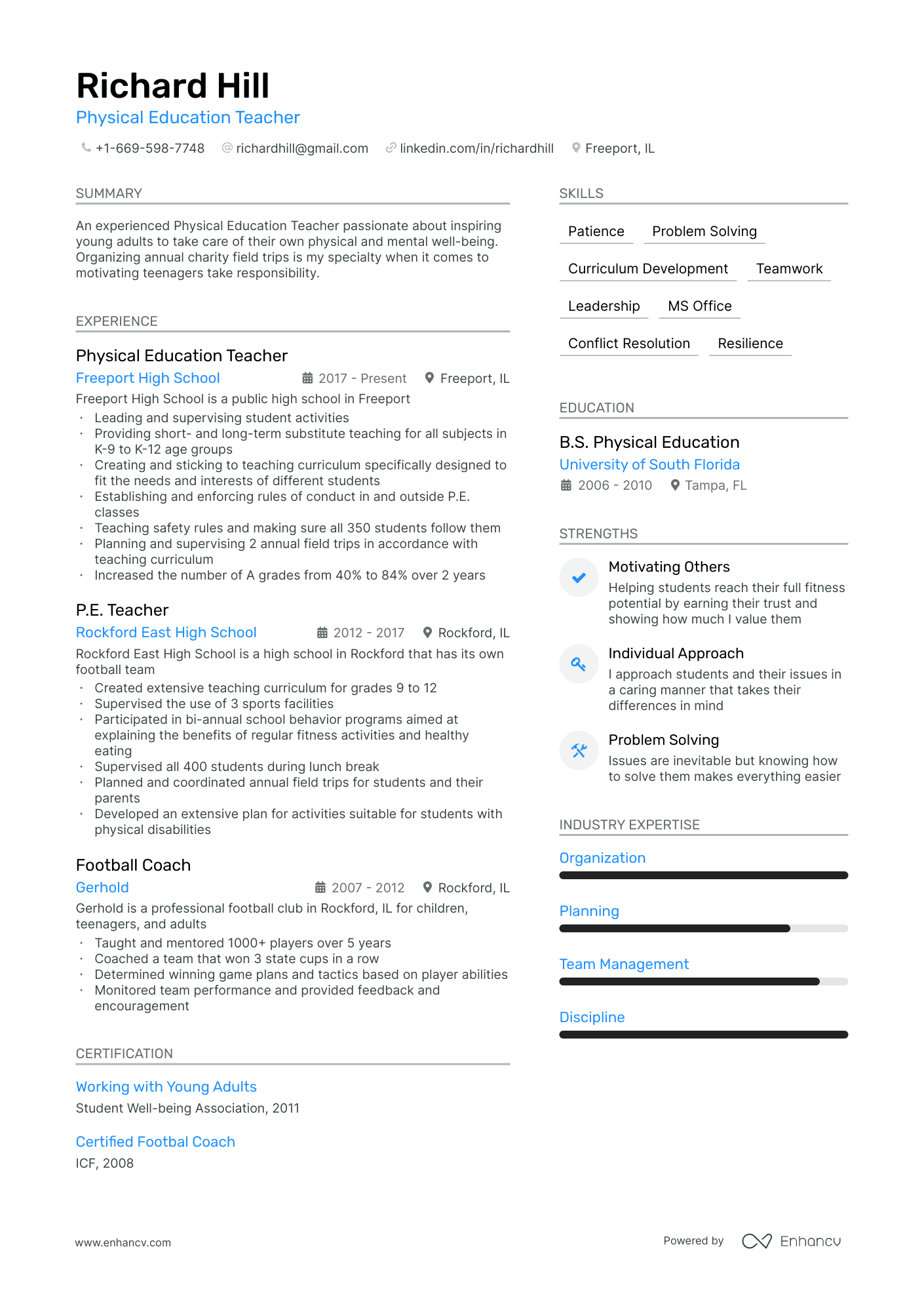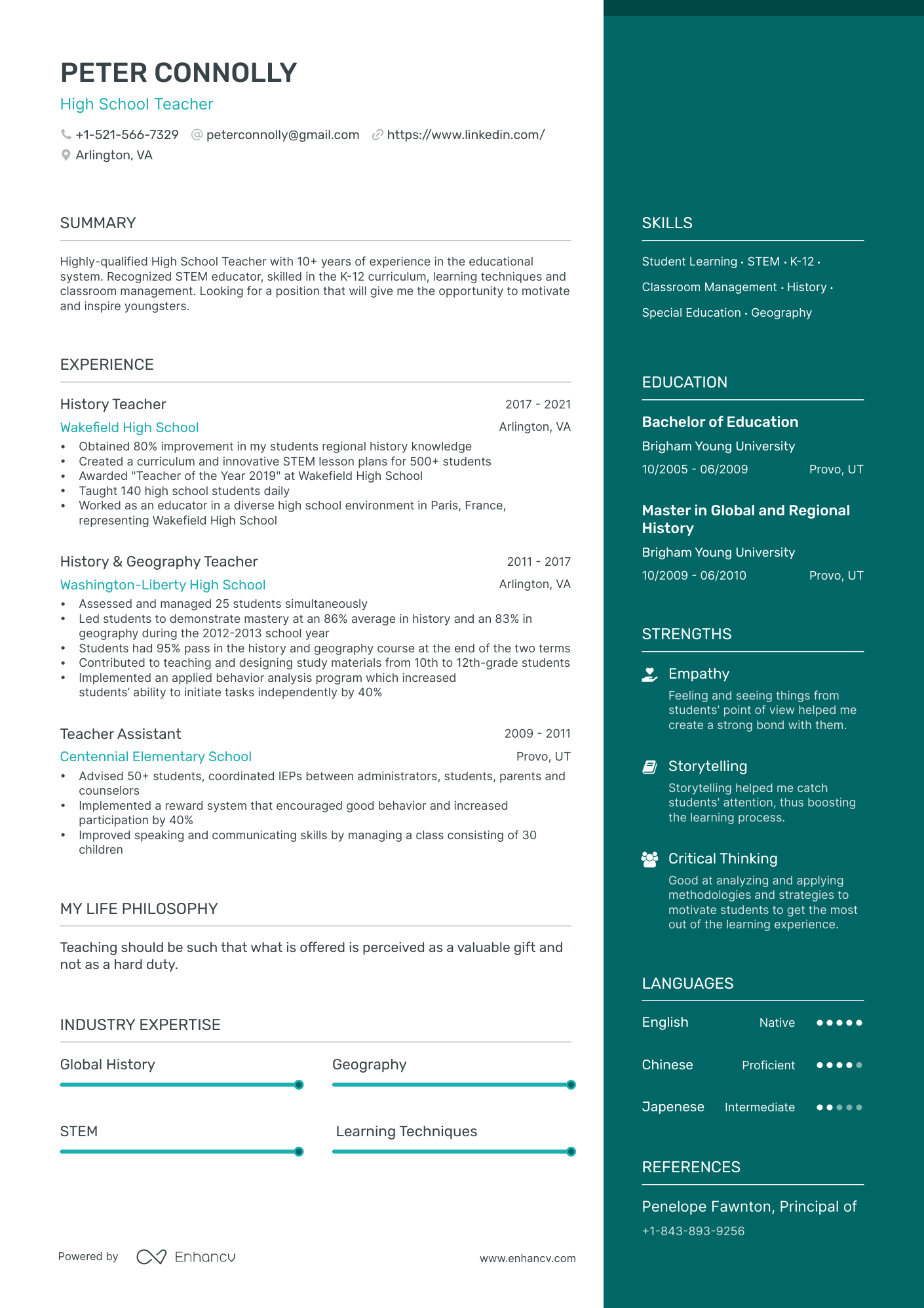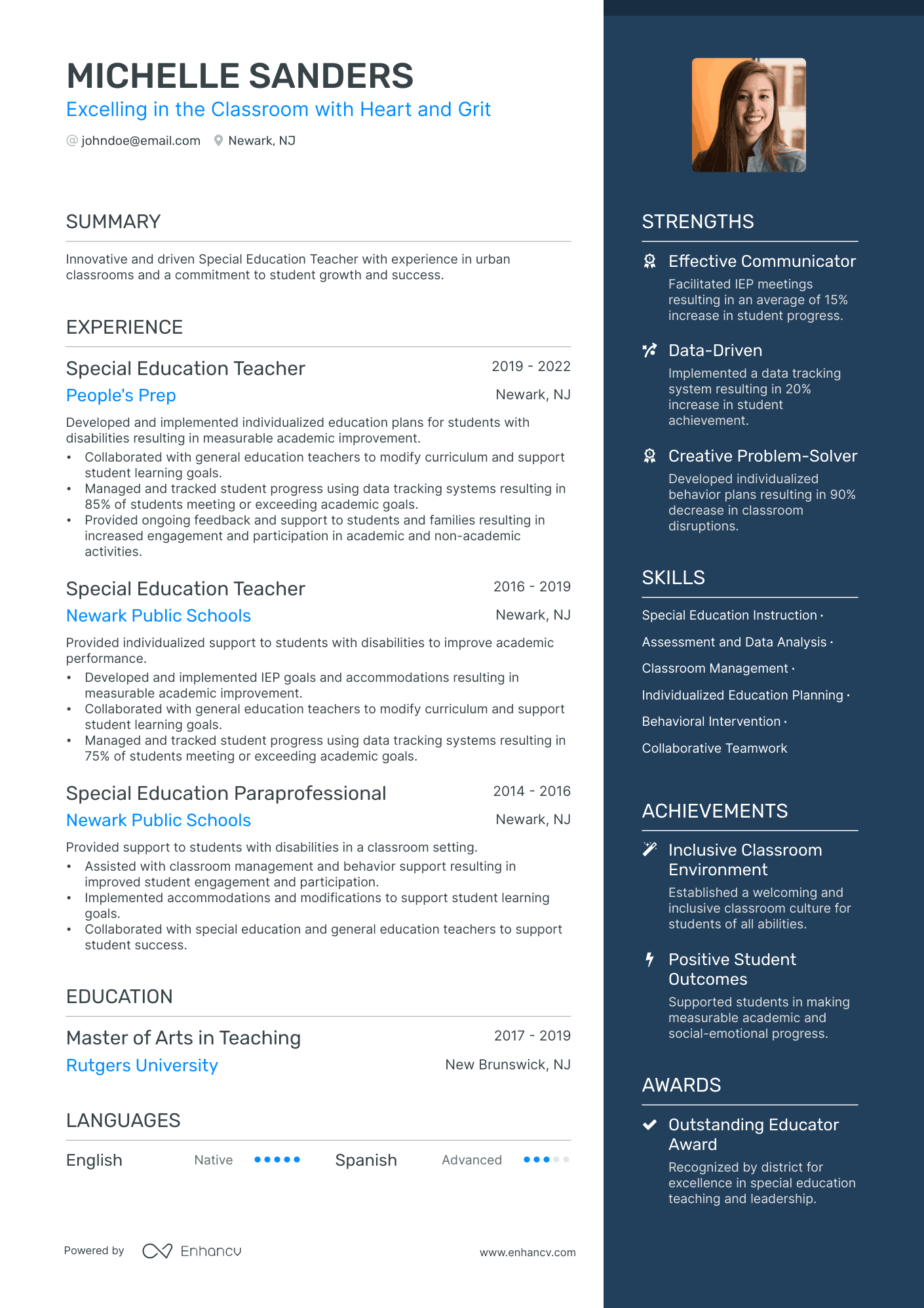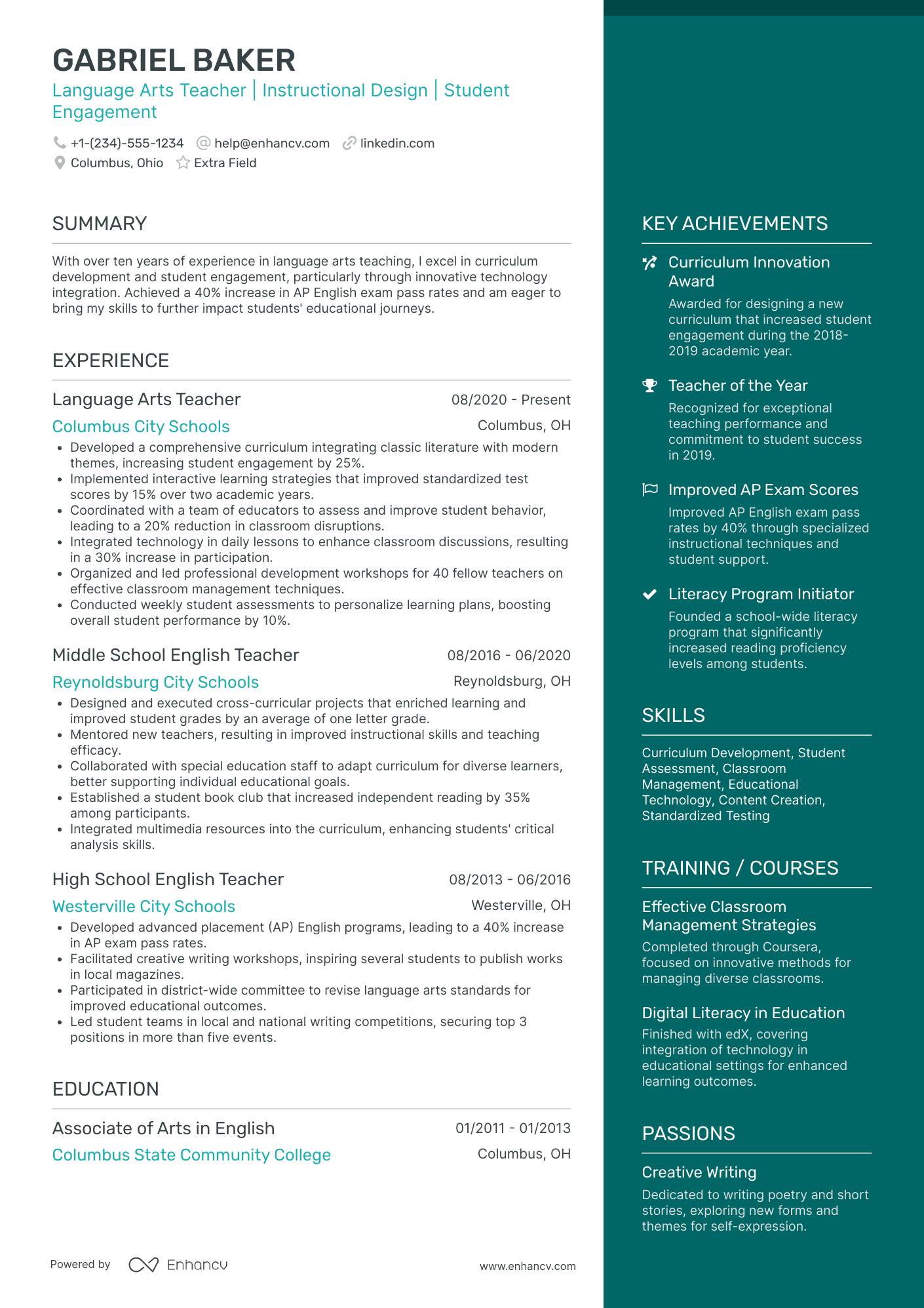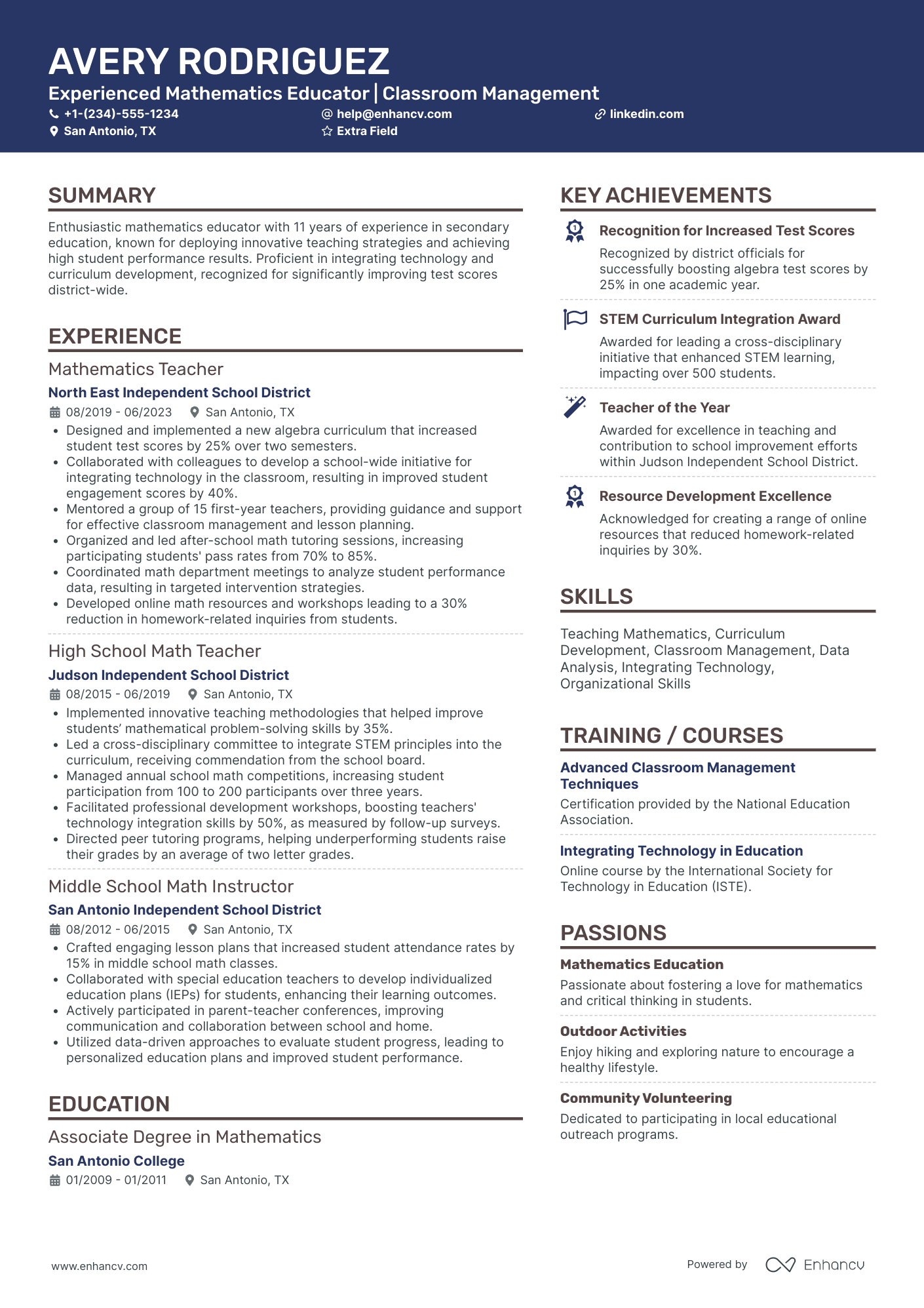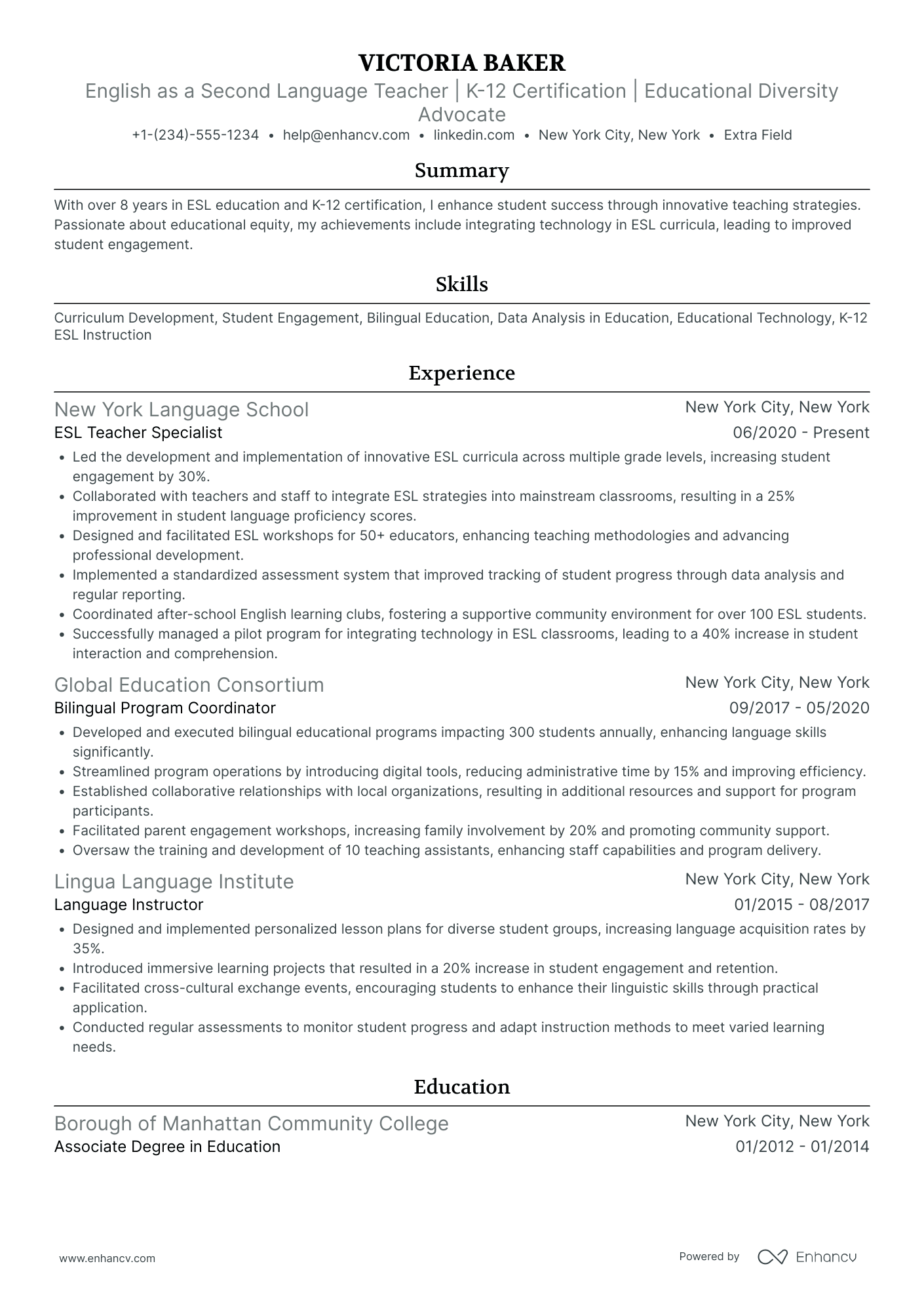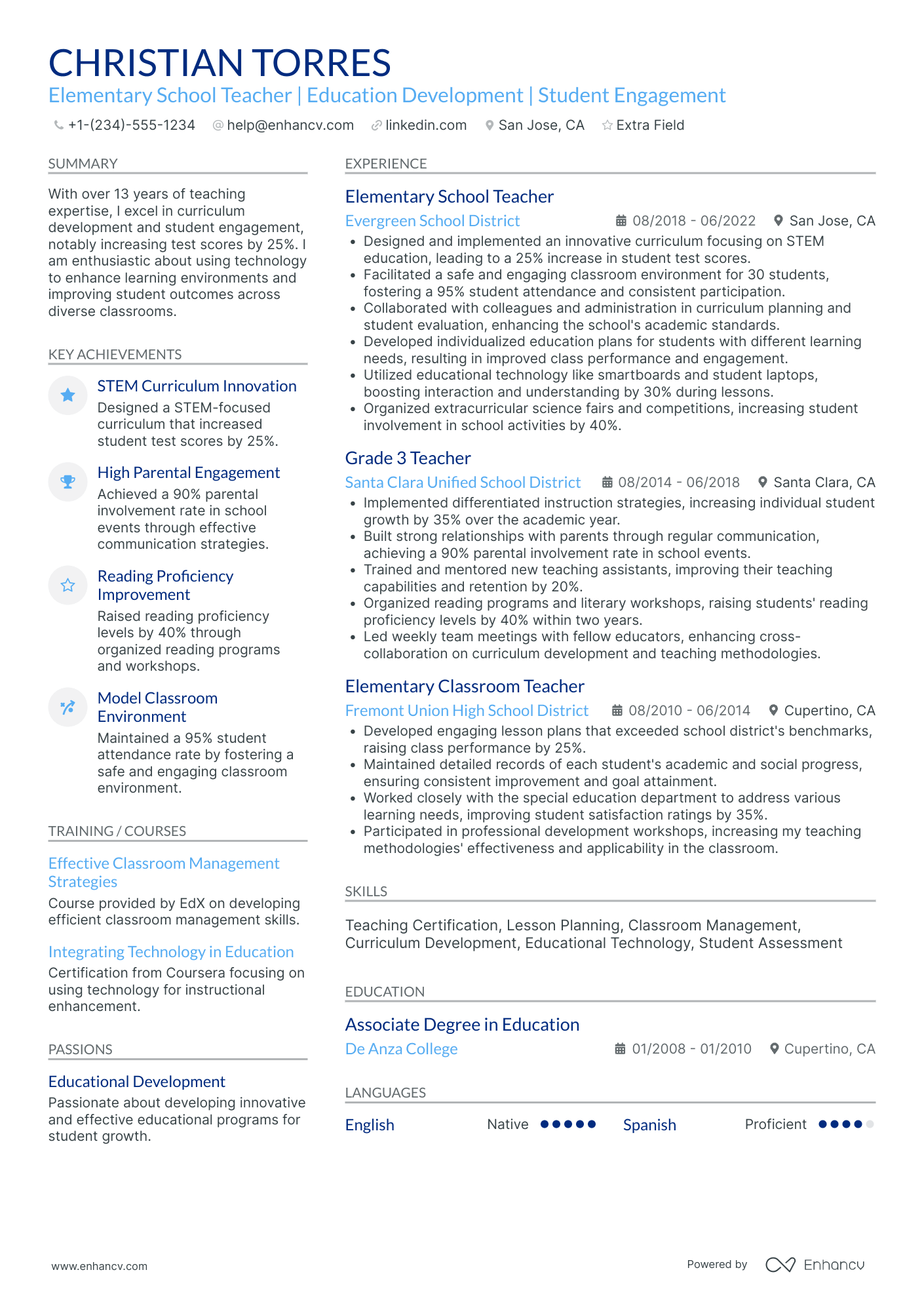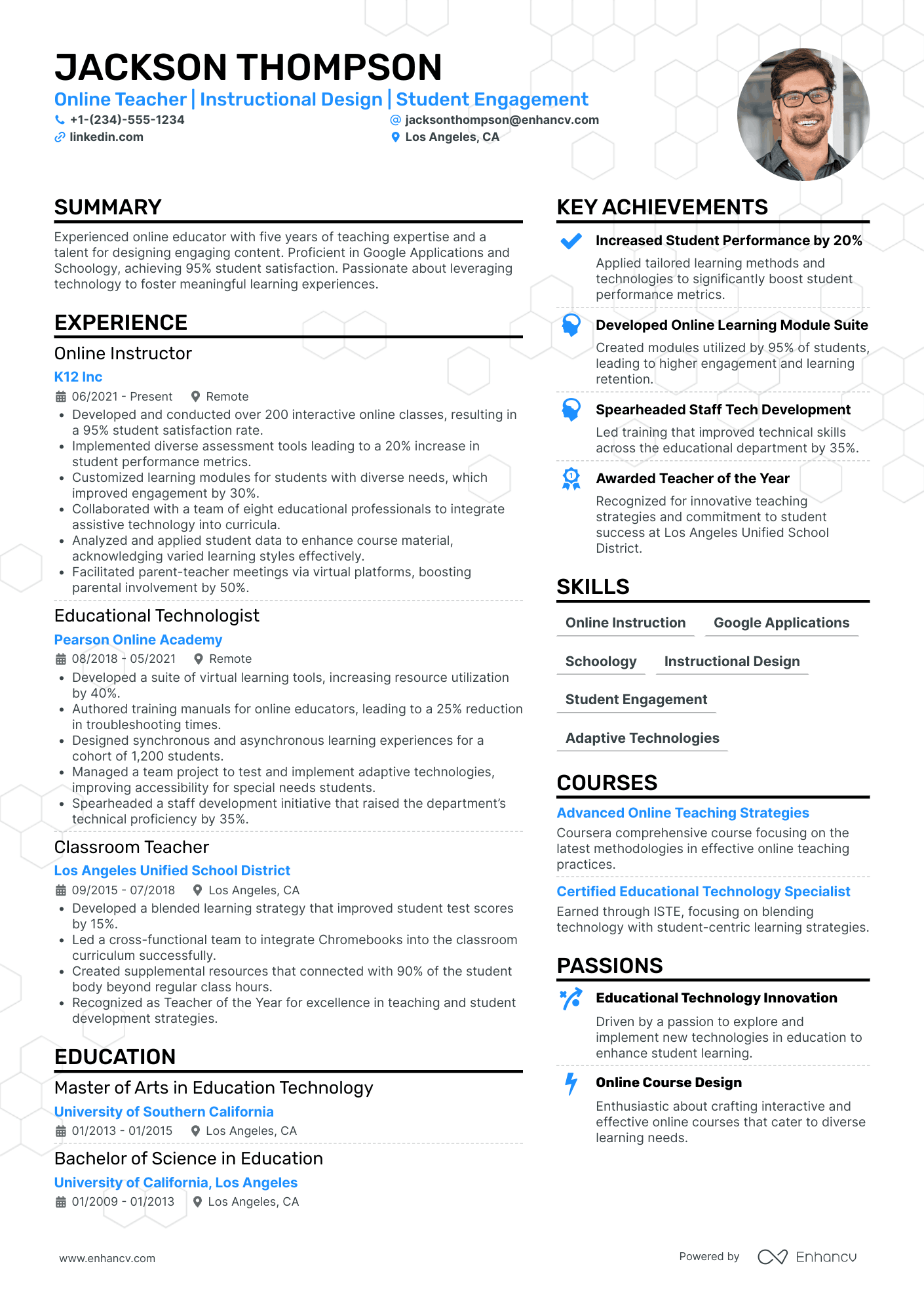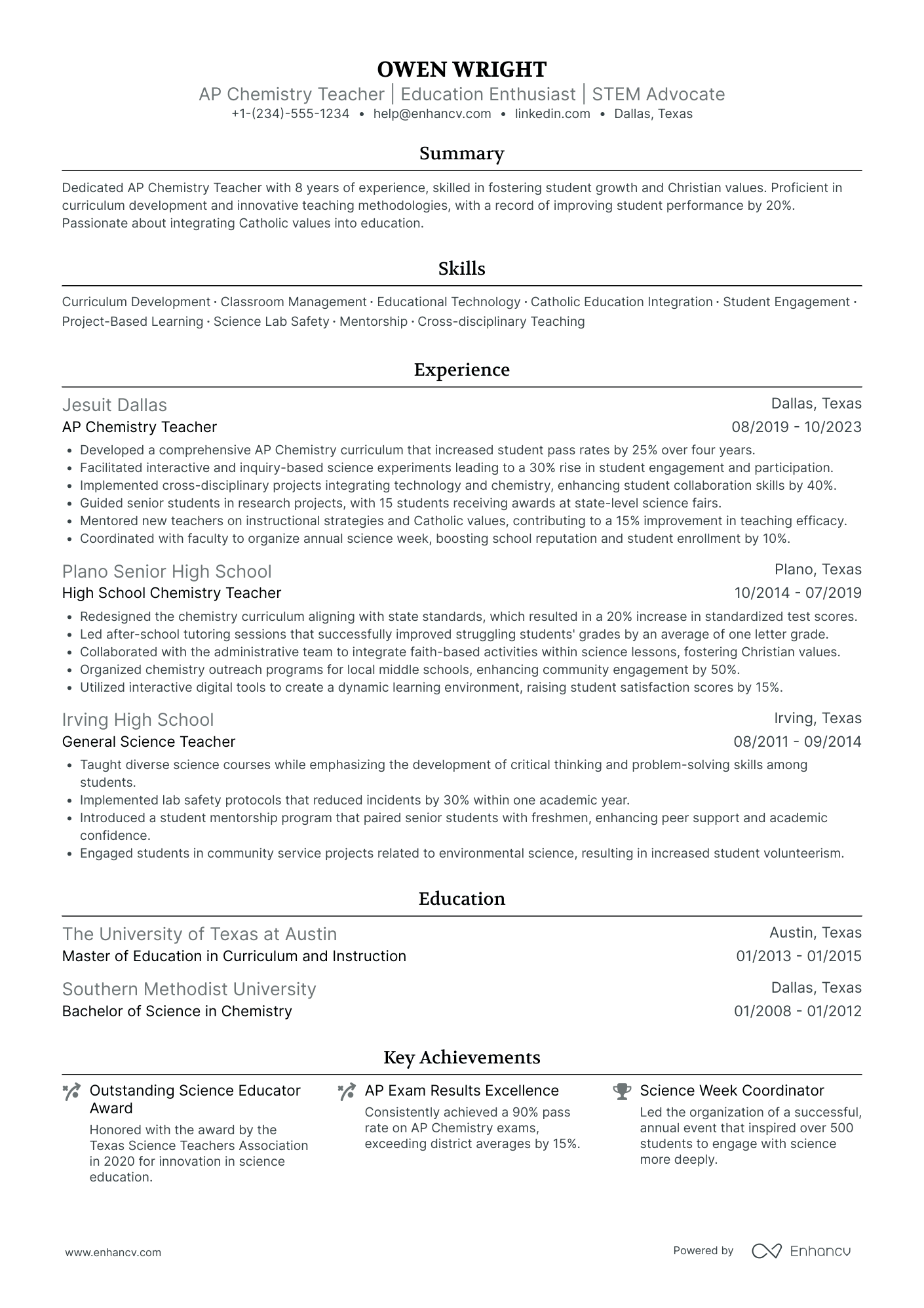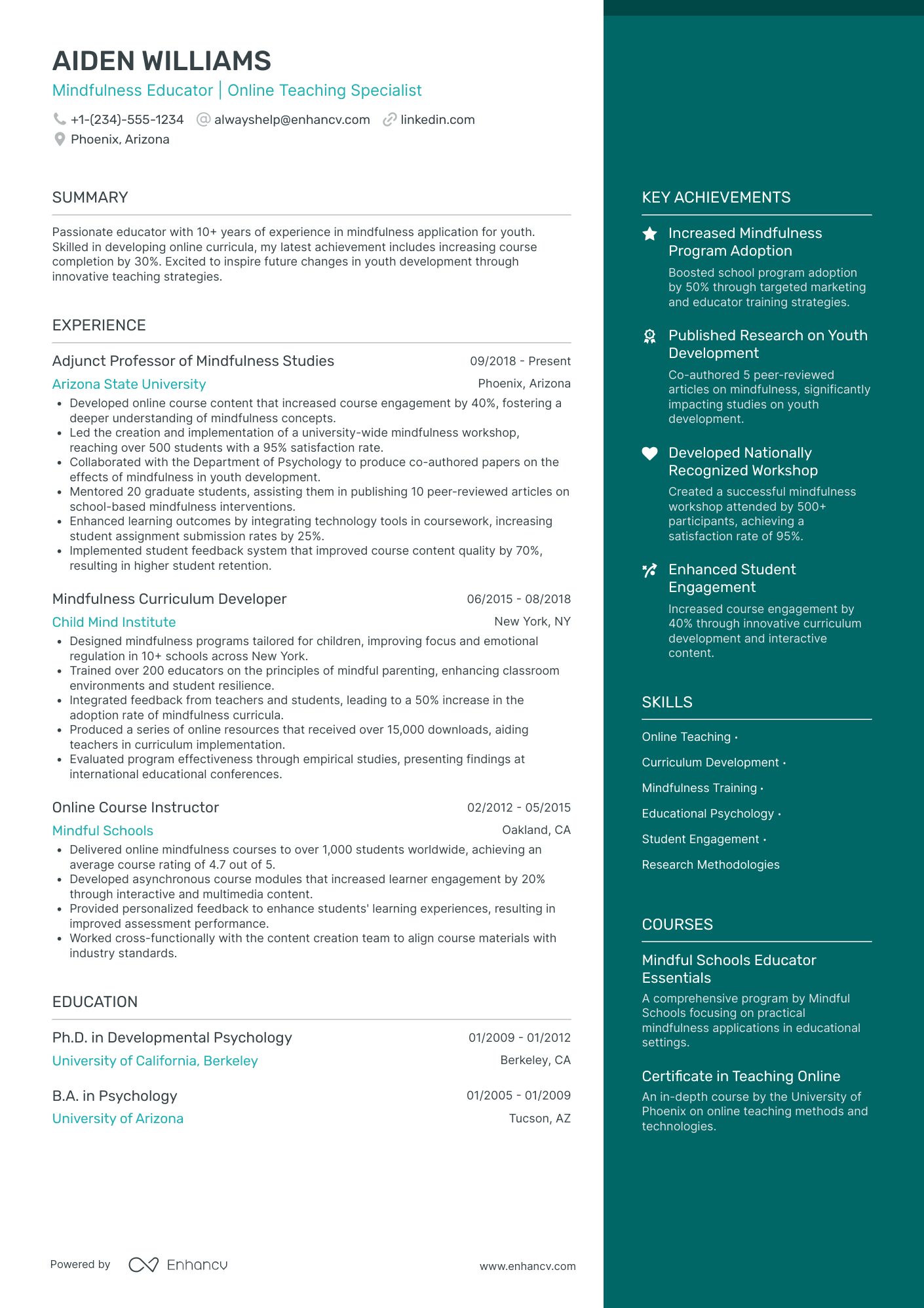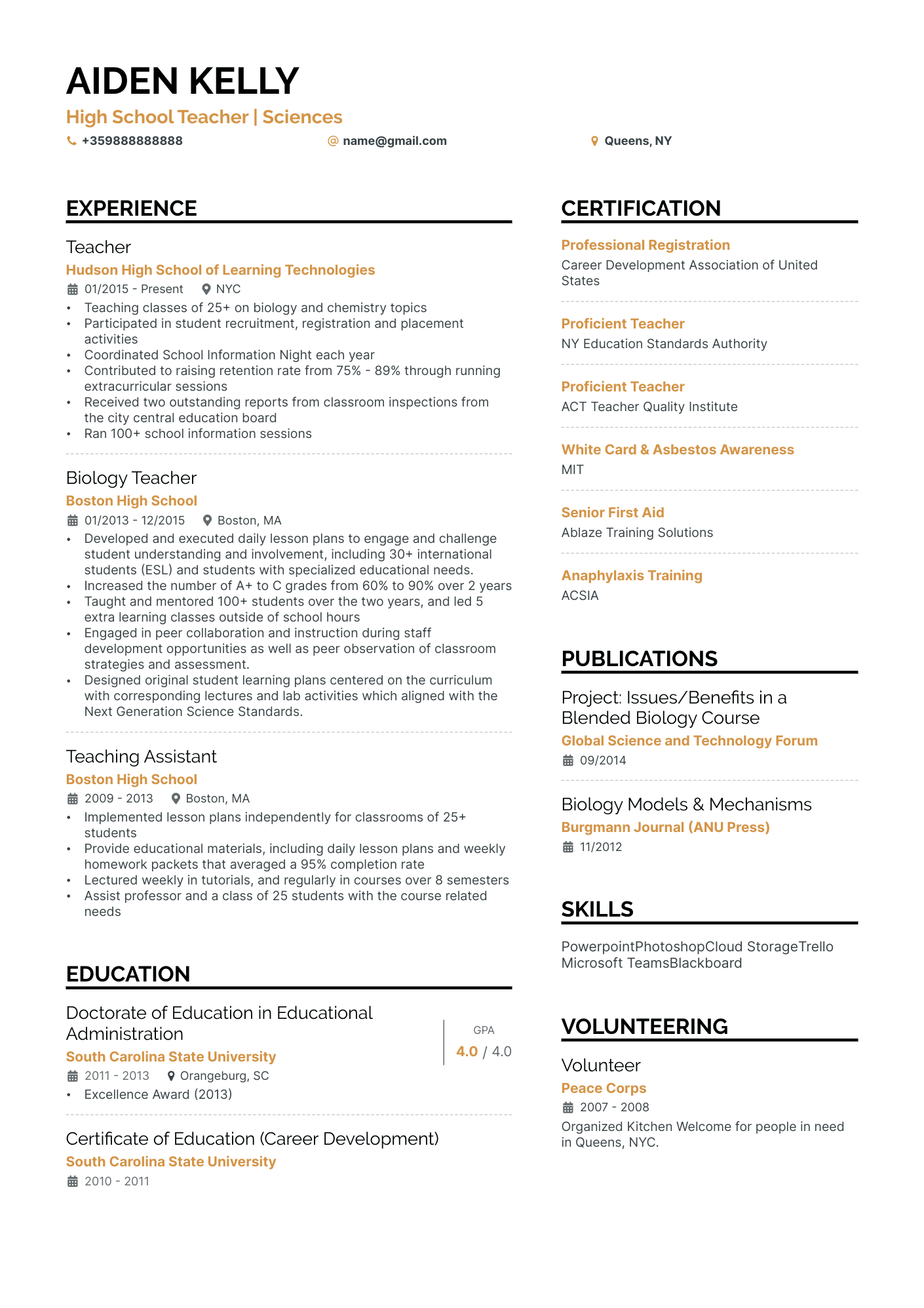The ongoing teacher shortage is prime time to grow your career. But to land the perfect job, you need the perfect resume.
That means a flawless layout with impeccable details about your past successes. Of course, you’re a pro at teaching, but writing your teacher’s resume might not be your top strength.
That’s ok, we’ve put together everything you need to write an impeccable resume that will land you your dream job. In this guide, we’ll cover:
- A teacher resume sample that ticks all the checkboxes
- The best formatting considerations for your resume
- Essential and optional sections to include with examples
- How to include a cover letter with your application
- Most frequently asked questions about teacher resumes
Teacher resume sample
This is a top-notch example of a teacher’s resume. It presents the candidate as an experienced, effective, and dedicated educator.
Some of the reasons why are:
Extensive Teaching Experience: The candidate has taught for several years at multiple schools, demonstrating their ability to handle diverse students and subjects.
Track Record of Achievements: These specific and quantifiable achievements lend credibility to the teacher's effectiveness and commitment to improving student outcomes.
Education and Certification: The candidate holds a PhD in Educational Administration and other certifications, demonstrating their commitment to ongoing professional development.
Publications and Volunteering: The candidate's publications and volunteering demonstrate their dedication to academic research, community service, and making a positive impact outside the classroom.
Resume format and sections
Formatting and good design are essential for a resume's readability and visual appeal - crucial characteristics to grab and hold a hiring committee’s attention. A well-structured resume also clearly conveys professionalism, increasing your chances of an interview.
Since teachers are trusted with so much responsibility, in most cases, it’s best that you align your resume to a conventional format. Choose a traditional format, with either one or two columns, instead of going for a flashy or creative resume.
The exceptions would be if you’re applying to an art school or other creative-oriented private school or if you’re applying to an art, music, drama, or other creative teacher position. In those cases, you might consider using a creative resume template.
Every teacher’s resume will be different, and each one you write should be tailored to the specific job you’re applying to. For example, you’ll want to highlight different skills as an art or a maths teacher, and likewise, if you’re teaching at the kindergarten, elementary, or high school level.
But, there are some fundamental aspects you should always bear in mind.
Use reverse chronological order
Typically, resumes are formatted in reverse chronological order. This means organizing your work and education history with the most recent experiences listed first and moving backward to the oldest.
This format makes it easy for employers to identify your most current and relevant work and skills. It demonstrates your career progression and helps potential employers understand your professional journey.
Properly format the header and contact info
A resume header is the first, and ome might say one of the most important parts of a teacher resume. It’ the section at the top of a resume that includes your name and contact information and is the first thing the recruiter will lay their eyes upon. It’s like your introduction, letting a potential employer know who you are and how to get get a hold of you.
A good header should include your:
- Full name
- Job title
- Phone number
- Email address
Additional and somewhat optional information is including your home address (which is traditional and not used so much anymore) and a link to your LinkedIn profile.
Be mindful of regional differences in resume formats – a Canadian layout, for instance, might vary.
Key sections
Beyond the header, your resume should highlight your relevant qualifications, experience, and the skills you bring to the job. The standard sections to include in your teacher resume are:
- Professional Summary or Objective: A brief statement that highlights your experience, teaching philosophy, or key strengths tailored to the specific teaching position you’re applying for.
- Work experience & Achievements: This section outlines your successful work history. Include the school's name, the grade level or subject you taught, the dates of your employment in reverse chronological order, and include quantifiable results from your time there.
- Skills: Showcase any relevant teaching and technical skills you have that might not be expected or that you can provide specific evidence of.
- Education: The details of your academic qualifications, including degrees, certifications, and relevant coursework.
- Certifications and licenses: List any relevant teaching licenses or certifications, along with their expiration dates, if applicable.
Number of pages
There’s an old rule of thumb that you should keep your resume to 1 page. While that may be true in some industries, it’s not always true for teachers.
Aim for a length that includes all the info you need to show you’re the best fit for the job, but avoid including unnecessary bloat. Keeping everything concise will ensure it’s readable and avoid looking cluttered.
A bit vague? Okay. As a rough guide, if you’ve been teaching for less than 4 years and don’t have much other experience or professional development, one page should do. If you’ve been teaching for a while and want to include some optional sections we cover later, you can stretch it to two pages.
If you’re a veteran teacher with many years of experience and you’ve been keeping up with professional development, you might consider going to three pages. And if you’re a post-secondary teacher with a long list of publications and conference presentations or other important accolades, you might even consider 4 or 5 pages.
File format: doc or pdf?
Once you’re ready to save your resume, you have two choices: a .PDF or a .Doc. I suggest saving it as a .PDF unless the employer has specified otherwise.
PDFs save all the formatting you just put so much time into. Unlike with a .Doc., there’s no chance your resume will print up wonky and undermine the professional image you’re trying to send.
Another consideration is that many employers now use applicant tracking systems(ATS) as the first step in the selection process. Luckily, all of our resume templates are preformatted and designed to play well with ATS, and they come as .PDFs, so you don’t have to worry about a thing.
The top sections on a teacher resume:
- Header
- Objective
- Work experience
- Skills
- Education & certifications
What recruiters want to see on your resume:
- Teaching experience. This is the most important factor, so highlight your experience in the classroom. Include the grade levels and subjects you've taught, and any specific teaching methods or strategies you've used.
- Education. A bachelor's degree in education is typically required for teaching positions, so list your degree and any relevant coursework.
- Certifications. Many teaching positions require specific certifications, so list any you have.
- Skills. In addition to teaching skills, recruiters are looking for teachers with strong communication, organization, and time management skills.
- Achievements. Be sure to highlight any awards or recognition you've received for your teaching and any specific accomplishments you're proud of.
- Personal qualities. Recruiters are also looking for teachers who are passionate about teaching, patient, and have a strong work ethic.
Work experience
This is the fundamental section of your resume. It’s your opportunity to show the hiring committee your teaching history, leadership skills, and commitment to education.
Ideally, this section will consist of teaching-relevant work experience. Your potential new school will prefer candidates with strong backgrounds in the field they’re applying in.
But if you transitioned into teaching after another career or it’s your first teaching job but you had other jobs beforehand, there’s plenty you can include. No matter what your past work experience was, if you give it careful consideration, you can identify transferable skills to demonstrate you’re a good fit.
Follow these guidelines to write a work experience section to capture the school board’s attention:
- List work experience in reverse chronological order.
- Include school name, dates, and job title.
- Mention the subject you taught, which grade level, and your average class size.
- Use keywords relevant to the teaching position, where your past experiences align with the job description.
- Focus on your accomplishments at each job rather than your basic duties.
Quantify accomplishments whenever possible, try toailor the accomplishments you include for each job you apply to.
- Include 4-6 accomplishments or duties for each job.
- Use action verbs to describe your work, like……..
Quantify impact
Quantifying your impact on a resume means including specific numbers, percentages, or measurable outcomes from previous jobs. These details showcase tangible results and lend credibility to your qualifications.
Some of the aspects of a teacher’s job you can quantify on your resume include:
- List improvements in specific student performance or academic achievements
- Are there classroom assessments of your students' average improvement or growth?
- What initiatives led to improved student attendance or engagement?
- What percentage of students and parents took part in school-related activities you organized?
- Mention any awards or other recognition you’ve received for contributions to the school, student achievements, or teaching methods.
- Have you successfully improved classroom behavior, attendance, or reduced disruptions?
Experience examples
Look over these examples of right and wrong ways to list your work experience to better understand how to write yours.
- •Designed and implemented engaging and student-centered lesson plans, resulting in a 15% increase in students' test scores.
- •Integrated technology to enhance learning experiences and foster student engagement, leading to positive feedback from students and parents.
- •Collaborated with colleagues to develop cross-curricular projects, promoting critical thinking and teamwork skills among students.
- •Demonstrated strong classroom management skills, creating a positive and disciplined learning environment conducive to effective learning.
- •Actively participated in faculty meetings, professional development workshops, and parent-teacher conferences, contributing to the school community and student success.
- •Taught math lessons to high school students.
- •Handled classroom management.
- •Used technology in the classroom.
- •Conducted parent-teacher conferences.
The right example showcases the teacher's accomplishments with active wording and quantifies their impact on student performance, which is attractive to potential employers. The wrong example is vague and lacks details. It doesn't highlight the teacher's skills or contributions.
- •Developed an innovative art curriculum resulting in a 25% increase in student engagement and creative expression.
- •Organized and facilitated three successful school-wide art exhibitions, showcasing over 300 student artworks and receiving positive feedback from parents and the community.
- •Collaborated with classroom teachers to integrate art into core subjects, enhancing students' overall academic performance and creativity.
- •Implemented classroom management strategies that reduced disruptions by 40%, creating a focused and respectful learning environment.
- •Conducted art workshops for parents and staff, receiving a 95% satisfaction rate and strengthening community involvement in the art program.
- •Taught art to elementary students.
- •Managed the art classroom.
- •Collaborated with other teachers.
The ‘right’ example includes quantifiable results that showcase the teacher's effectiveness and contributions, making the resume stand out to potential employers. The ‘wrong’ example is ineffective as it lacks specific details and outcomes, which makes it less impactful for potential employers.
- •Designed and implemented inquiry-based science labs resulting in a 20% improvement in students' understanding of scientific concepts.
- •Coached the school's Science Olympiad team to win three regional championships and qualify for the state competition for the past two years.
- •Utilized technology to create interactive virtual labs, leading to a 30% increase in student engagement and participation.
- •Collaborated with the school's science department to align curriculum with state standards, resulting in a 10% improvement in standardized test scores.
- •Conducted weekly after-school tutoring sessions, resulting in a 95% passing rate for struggling students.
- •Taught science to high school students.
- •Coached Science Olympiad team.
- •Used technology in teaching.
- •Collaborated with other teachers.
- •Conducted after-school tutoring.
The right example measurably demonstrates their effectiveness and includes extracurriculars that shows them as a well-rounded and involved teacher. The wrong example only lists basic responsibilities without evidence of the teacher's effectiveness or achievements.
Skills
Why include a skills section?
A skills section on a teacher's resume is important because it provides a concise and organized overview of the teacher's key strengths, competencies, and qualifications. Here's how:
Showcases relevance: The skills section highlights the teacher's relevant abilities, ensuring employers quickly identify their suitability for the position.
Easy to scan: A well-organized skills section lets hiring managers quickly grasp the teacher's essential strengths and decide whether to continue reading the resume.
Demonstrates expertise: The skills section demonstrates the teacher's diverse expertise, showcasing the various aspects of teaching they excel at.
Quantifies impact: Quantifiable results and achievements within the skills section offer concrete evidence of the teacher's effectiveness. This makes the resume more compelling and memorable.
Tailored: The skills section should be customized to match the requirements of different teaching positions, highlighting the most relevant skills for each application.
Strengthens first impression: The skills section is usually placed near the top of the resume, catching the reader's attention early on. It sets a positive impression that encourages a recruiter to continue reading the entire document.
Step by step how to list
A strong skills section takes a little organization and thought. Here's a step-by-step guide to showcase your skills:
- Identify relevant skills: Tailor your skills section to the specific job description.
- Group and prioritize: Organize your skills and prioritize the most relevant ones.
- Be specific: Describe your skills clearly and provide quantifiable results.
- Use concise bullet points: Present your skills in bullet points and avoid lengthy paragraphs.
- Be honest: Include only skills you actually have, and be honest in your presentation of them.
Hard skills and soft skills
Hard and soft skills are essential for a successful teaching career. When applying for a teaching position, it is important to highlight both skill types in your resume and cover letter.
Hard skills are specific, teachable abilities that are directly applicable to a job or profession. They’re often quantifiable and measurable.
Soft skills are intangible, interpersonal qualities that improve communication and collaboration and may rely on emotional intelligence. They’re not as easily quantifiable as hard skills, but they’re essential for a teacher’s success.
Best hard skills for your teacher resume
- Classroom management
- Curriculum development
- Differentiated instruction
- Assessment and evaluation
- Data analysis
- Technology integration
- Subject matter expertise
- Special education
- Classroom technology management
- Literacy and reading strategies
- Numeracy and math instruction
- Science laboratory skills
- Foreign language proficiency
- Project-based learning
- Conflict resolution
- Classroom technology integration
- Time management
Best soft skills for your teacher resume
- Communication
- Empathy
- Patience
- Adaptability
- Active listening
- Collaboration
- Problem-solving
- Creativity
- Emotional intelligence
- Flexibility
- Cultural sensitivity
- Leadership
- Organization
- Conflict resolution
- Critical thinking
- Teamwork
- Classroom management
- Motivational skills
Example skills sections
Nobody has all the skills we’ve listed, and no principal will expect you to. The best resume skills sections include a mix of hard and soft skills most relevant to the specific job opportunity.
Here are four examples of how to adapt a skills section for different teaching jobs and experience levels, and to highlight d
Experienced teacher
Professional Skills
- Leadership: Exhibit effective leadership skills to facilitate an ongoing learning environment.
- Differentiated Instruction: Effectively adapt lesson plans for diverse learners.
- Effective Communication: Collaborate openly with students, parents, and colleagues.
- Technology Integration: Skillful use of educational technology.
- Empathy: Create a supportive and inclusive classroom environment.
New teacher
Professional Skills
- Classroom management: Create and maintain a positive and disciplined learning environment.
- Curriculum development: Design and adapt lesson plans to meet the diverse needs of learners, ensuring all students succeed.
- Flexibility: Demonstrate adaptability and openness to foster a cooperative learning environment.
- Science lab skills: Utilize expertise in science laboratory techniques to enhance teaching and student engagement.
- Culturally responsive teaching: Cultivate a supportive and inclusive classroom atmosphere, respecting and celebrating diversity.
Elementary teacher
Professional Skills
- Engaging classroom environment: Foster active participation for elementary students.
- Adaptive curriculum development: Design age-appropriate lesson plans for diverse learners.
- Patience and flexibility: Address individual learning styles and varying abilities.
- Interactive teaching methods: Use hands-on activities to enhance learning experiences.
- Inclusive approach: Cultivate a supportive classroom atmosphere, promoting a sense of belonging.
Substitute math teacher
Professional Skills
- Adaptability: Quickly adapt to different classroom settings.
- Mathematics proficiency: Demonstrate strong expertise in mathematics to teach and explain concepts to students effectively.
- Communication: Concisely convey complex math topics to students of varying skill levels.
- Classroom management: Maintain a positive and orderly learning environment during temporary teaching assignments.
- Problem-solving: Effectively address challenges that arise in the classroom.
Education / certifications
It’s no mystery that you need a good education to be a teacher. Each school district can be different, but a teacher needs at least a bachelor's degree, in education or the subject they teach, along with a teaching certificate or license.
In most cases, though, the basics aren’t enough. Additional requirements, like teacher competency exams, specific training, background checks, or other expectations, may also apply.
Which education/certification is relevant?
As an example, to teach at the high school level, you typically need the following education and certifications:
- Bachelor's Degree: A bachelor's degree in the subject you'll teach is usually required.
- Teacher certification/license: A teaching certificate or license is required in most regions.
- Subject matter competency: A high school teacher is certainly expected to understand the subjects they teach.
- Background check: A background check is typically required before hiring.
- Continuing education: Some regions require you to pursue professional development to maintain your teaching credentials.
The specific education and certifications you’ll need will vary depending on the location and education system in place. So look up the specific requirements in your area to confirm you meet the expectations there.
How to list degrees and awards
As a teacher, it’s essential that you list your degrees (in reverse chronological order) on your resume. Include the degree name, major, institution, and graduation date.
Listing majors and minors on a teacher's resume is optional but can be beneficial if they're relevant to the teaching position or add value to your qualifications. Include them in the same section just below your degree entries.
Awards can highlight your dedication, accomplishments, and recognition as a professional educator, making you a more attractive candidate. List them in a separate section or under Education if they’re academic or teaching-related honors.
Mention the name of the award, the granting organization, and the date received. Emphasize awards demonstrating your teaching excellence, subject expertise, leadership, or contributions to the educational community.
- •What knowledge or experience did you acquire during your studies there? (e.g. Delivered a comprehensive marketing strategy)
This concise, organized education and awards section lists two degrees from top schools, including a master's from Harvard. It shows the candidate's commitment to teaching and learning, making them a compelling, competitive candidate.
The certification and awards sections identify their state teaching license and relevant certifications, underscoring their commitment to continuous learning. Their awards lend specific credibility to their success and effectiveness as a teacher.
Resume objective / summary
A resume objective is a short statement at the top of your resume that summarizes your career goals and why you’re applying for a particular job. Including an objective is important to catch the hiring committee's attention and highlight your skills and experience.
A teacher's resume objective should be short and to the point, highlighting the skills and experience relevant to the position you’re applying for. It should also be specific, mentioning the specific type of teaching position you’re interested in.
Here are some tips for crafting an attention-grabbing objective for your teacher resume:
- Start with a strong action verb. This will help to grab the hiring manager's attention.
- Include your skills and experience. Be specific about what you can do and your achievements.
- State the type of teaching position you’re interested in.
- Use keywords to help your resume pass through an applicant tracking system (ATS).
- Proofread carefully. Typos and grammatical errors are unacceptable on a teacher’s resume.
It may be tricky to fit all that into one or two sentences. Check out these examples and explanations of strong and weak teacher objectives to better understand how to write yours.
Optimize your resume summary and objective for ATS
Drop your resume here or choose a file.
PDF & DOCX only. Max 2MB file size.
Strong teacher Objectives
These objectives are strong because they’re short, to the point, and specific. They also describe the candidate's value proposition, and the type of teaching position they’re interested in, and include relevant keywords.
Weak teacher Objectives
These objectives are weak because they’re vague, general, and don’t provide any specific information about the candidate's skills or experience. They also don’t mention the type of teaching position the candidate is interested in.
Other sections to include
There are a few optional teacher resume sections that you should consider including. Whether or not to include these sections is up to you, but showcasing these qualifications is a great way to make your resume stand out.
Awards & certification
Use this section to highlight any awards or certifications you’ve received to demonstrate the full breadth of your skills and experience.
Languages
Showing that you’re bilingual or multilingual can be valuable, especially in a school with a diverse student population.
Interests & hobbies
Include this section to show you’re well-rounded and have interests outside of teaching, which can make you a more interesting and engaging teacher.
- Interests & Hobbies:
- Hiking
- Camping
- Reading
- Playing guitar
- Learning new languages
Publications
Highlight any publications you’ve authored or co-authored to demonstrate your research skills and knowledge.
Publications
- "Teaching Math to English Language Learners," published in the Journal of Mathematics Education for Language Minority Students
- "Using Technology to Enhance Learning in the Mathematics Classroom," published in the Journal of Educational Technology
- "The Impact of Different Teaching Strategies on Student Achievement in Mathematics," published in the Journal of Educational Research
Presentations
The presentations you’ve given demonstrate your communication and public speaking skills and expertise in the subject you teach.
Presentations
- "Teaching Math to English Language Learners," presented at the National Council of teachers of Mathematics (NCTM) annual conference.
- "Using Technology to Enhance Learning in the Mathematics Classroom," presented at the International Society for Technology in Education (ISTE) annual conference.
- "The Impact of Different Teaching Strategies on Student Achievement in Mathematics," presented at the American Educational Research Association (AERA) annual conference.
Custom section title based on a job
A custom section is an opportunity to give the school or board you’re applying to better understand why you’re a great fit for a job. Consider including one if you want to showcase your skills in a specific job requirement in the job description.
To create a custom section, start by identifying the skills and experience that are most relevant to the job you are applying for. The section should be concise and easy to read, and it should use keywords that are relevant to the job.
Here are some examples of custom sections that you might include on your resume:
- Experience with STEM Education
- Experience with Teaching English as a Second Language (ESL)
- Experience with Special Education
- Experience with Technology Integration
- Experience with Project-Based Learning
And here’s how you can lay one out:
Experience with STEM Education
- Developed and implemented a STEM curriculum for elementary school students
- Led a team of teachers in the implementation of the STEM curriculum
- Trained teachers on how to use STEM resources and activities
- Presented on STEM education at professional conferences
Cover letter matching your teacher's resume
It’s crucial that you include a cover letter as part of your application for a teaching job. It’s your opportunity to introduce yourself to the hiring manager, explain your interest in the position, and highlight your skills and experience.
A well-written cover letter can help you stand out from the competition and increase your chances of getting an interview. Follow these five steps to write a standout cover letter to complement your resume.
- Start with a strong introduction. This is your chance to introduce yourself and explain your interest in the position.
- Highlight your skills and experience. Show why you’re the best candidate for the job with specific, quantifiable examples of your skills and experience.
- Explain why you are interested in the position. Let the school know what excites you about the position or what you can contribute there.
- Tailor your letter to the specific position. Research the school and position to show you’ve taken the time to learn about them and that you’re genuinely interested.
- Proofread carefully. Typos and grammatical errors are absolutely not acceptable on a teacher’s resume.
Teacher resume examples
By Experience
Teacher Assistant
Substitute Teacher
Head Teacher
Master Teacher
Senior Teacher
By Role
Art Teacher
Bilingual Teacher
Biology Teacher
Computer Science Teacher
Creative Art Teacher
Dance Teacher
The Dance Teacher position boasts a rich history with roots in performing arts and physical education. Thus, trends in these areas often shape the dance teaching field.
The following advice will help you apply more effectively for Dance Teacher jobs:
- Practice and expertise in different dance styles are key. Ballet, Contemporary, Hip Hop, Jazz, and Latin. Successful dance teachers often have a versatile and extensive understanding of various genres.
- Highlight any experience in choreographing and staging dance performances. Lack of this can lead to early dismissal.
- Prioritize the dancing background that has impacted your teaching. Most accomplished dance teachers have a strong performance record, so emphasize your dancing experience and its influence on your teaching methodology.
- Don't merely list dance styles or shows you've performed in. Highlight how your knowledge improved your students' skills, e.g., "improved students' flexibility through...", "increased students' stage presence after..." etc. Stick to the "skill-action-results" pattern.
History Teacher
Language Teacher
Lead Teacher
Math Teacher
Music Teacher
Piano Teacher
Retired Teacher
Science Teacher
Social Studies Teacher
Spanish Teacher
Teacher For Career Change
Technology Teacher
Theatre Teacher
Transitioning Teacher
Early Childhood Teacher
Physical Education Teacher
High School Teacher
Special Education Teacher
Language Arts Teacher
Mathematics Teacher
English as a Second Language Teacher
Primary School Teacher
Online Teacher
- Clear and Structured Presentation - The resume presents Jackson Thompson's qualifications in a concise and organized manner, moving from personal details to professional experience, education, and additional skills. Each section is clearly delineated, making it easy for potential employers to quickly assess his qualifications and relevance to the role of an online educator.
- Demonstrated Growth in Educational Technology - Jackson's career trajectory shows significant growth, transitioning from a classroom teacher in a traditional setting to an online instructor and educational technologist. This progression indicates his adaptability and willingness to embrace new educational paradigms, enhancing his value in the online education sector.
- Integration of Technological Tools and Methods - The resume highlights Jackson's proficiency with industry-specific tools such as Google Applications and Schoology, which are crucial for effective online teaching and instructional design. His experience with implementing assistive and adaptive technologies underscores his technical depth and commitment to creating inclusive learning environments.
Chemistry Teacher
- Effective Content Presentation - Owen Wright's resume is effectively structured with a clear, logical flow, beginning with essential contact information followed by a strong summary. Each section is concise, yet comprehensive, showcasing his role-specific expertise. Bullet points are well-crafted to provide impactful insights into his achievements, without overwhelming the reader with information.
- Impressive Career Trajectory - The evolution of Owen's career from a general science teacher to an AP Chemistry teacher at prominent schools demonstrates significant professional growth. His leadership roles and initiative in curriculum development and mentorship have consistently progressed, showcasing dedication and advancement in his teaching career and alignment with his passion for education and STEM advocacy.
- Strong Achievements and Impact - The accomplishments highlighted in Owen's resume underscore his impact on student performance and engagement. By quantifying improvements, such as increasing pass rates by 25% and achieving a 90% AP exam pass rate, his contributions to educational excellence are evident, confirming his ability to foster academic success and enhance the educational environment he is part of.
Mindfulness Teacher
- Effective Content Presentation - The resume is structured to convey information clearly and concisely, utilizing sections such as experience, education, skills, and achievements that allow an easy review of the candidate's qualifications. Each section is tailored to reflect the role of a Mindfulness Educator, making it easy for recruiters to identify relevant expertise and accomplishments.
- Strong Career Trajectory - Aiden has shown a strong progression in their career, moving from being an Online Course Instructor to a Mindfulness Curriculum Developer, and then to an Adjunct Professor. This upward trend indicates professional growth and increased responsibility over time, highlighting their dedication and expertise in mindfulness education and curriculum development.
- Emphasis on Cross-Functional Collaboration and Adaptability - Aiden’s experience highlights their ability to collaborate with different departments and adapt to various roles. For instance, working with both the Department of Psychology and content creation teams shows their cross-functional skills. This adaptability is essential for a role that integrates educational psychology with online teaching methodologies.
Key takeaways
- Use a clear and concise font with plenty of white space to make your resume easy to read.
- Use clear and concise headings to organize your resume.
- Use the reverse chronological order.
- Include a summary statement that highlights your skills and experience. It’s easiest to write this last.
- Your education and teaching experience sections are critical. Make sure you include your greatest accomplishments in the field.
- Include a section for your skills, including hard skills and soft skills.
- Consider adding additional sections, such as awards and honors, publications, or volunteer work.
- Use keywords throughout your resume to be picked up by applicant tracking systems (ATS).
- Quantify your accomplishments whenever possible.
- Use action verbs to describe your skills and experience.
- Include a cover letter highlighting your skills and experience and explaining why you're a great fit for the teaching position!
